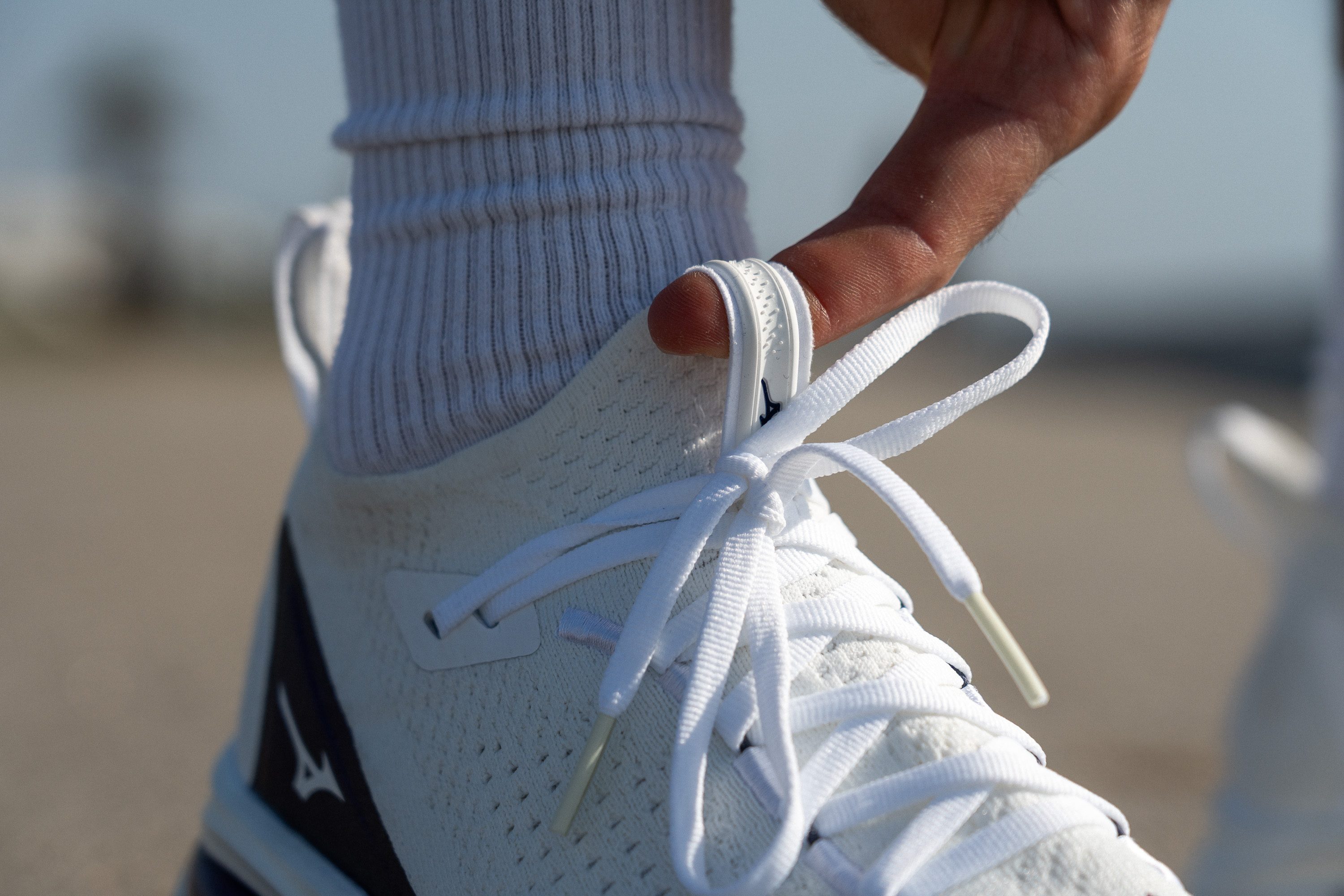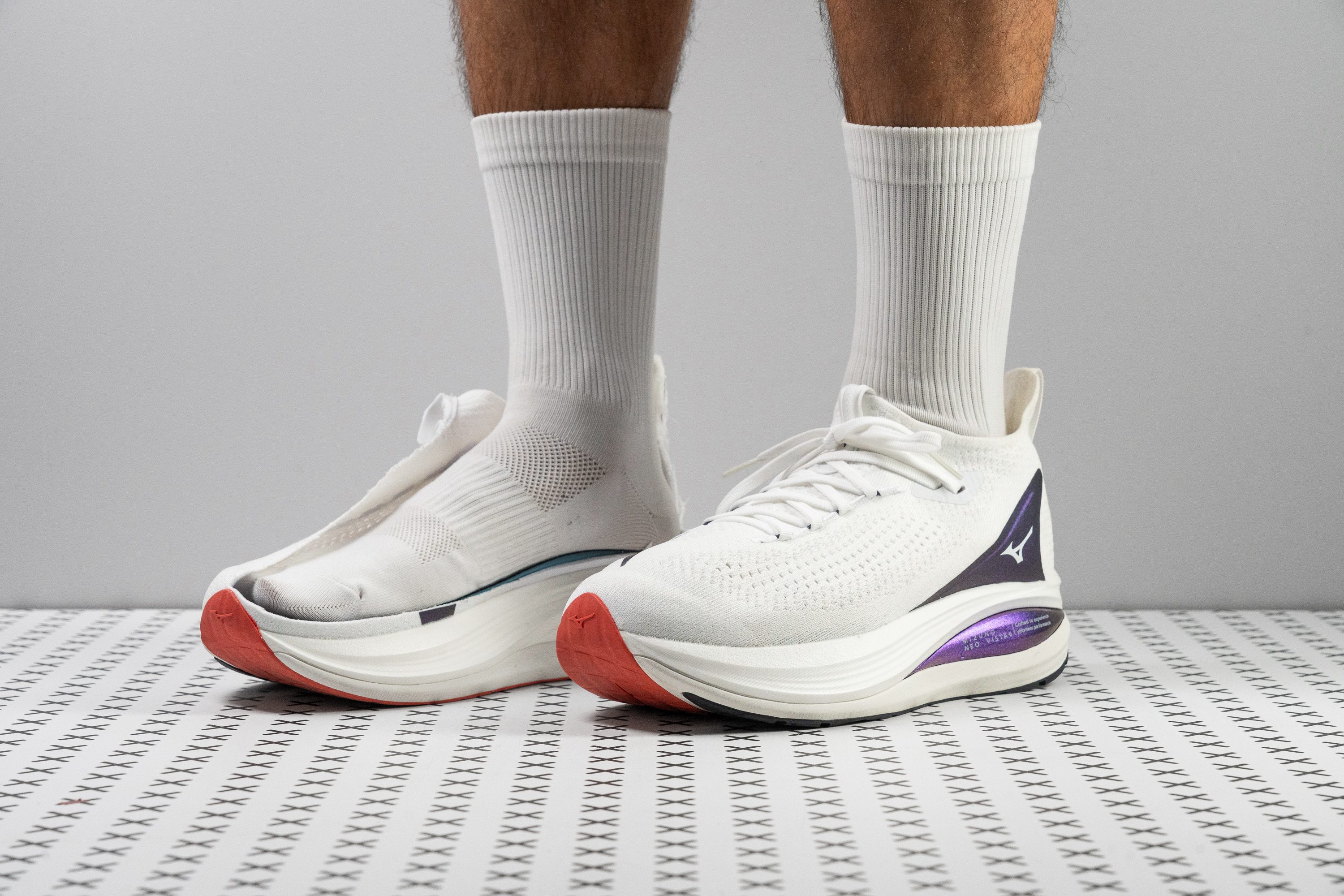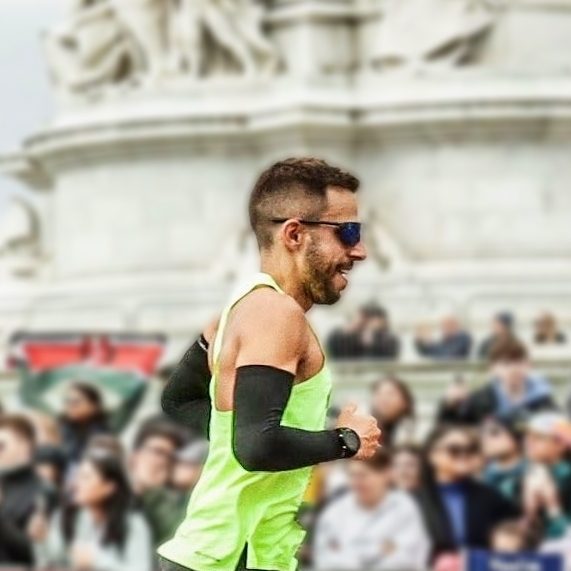Nuestra conclusión
Pros
- Suela altísima
- Espuma Enerzy NXT muy mullida
- Perfectas para distancias largas
- Ligeras para lo grandes que son
- Duraderas
- Upper de knit transpirable
- Parte delantera con bastante volumen vertical
- Muy divertidas
Contras
- No ofrecen suficiente retorno de energía
- No justifican el aumento de precio
- No son estables para los talonadores
Veredicto de los usuarios
- Top 18% más vendidas zapatillas de running
Comparativa
Las zapatillas de running más parecidas
+ + Añadir unas zapatillas | |||||
|---|---|---|---|---|---|
| Puntuación global | 83 Buenas | 91 Excelentes | 85 Buenas | 88 Notables | |
| Precio | 180 € | 190 € | 160 € | 270 € | |
| Pace | Correr a diarioTempo / series | Correr a diario | Correr a diario | Correr a diario | |
| Absorción de impactos | Alta | Alta | Alta | Alta | |
| Retorno de energía | Moderado | Moderado | Bajo | Bajo | |
| Tracción | Alta | Moderada | Alta | Alta | |
| Arch support | Neutral | Neutral | Neutral | Neutral | |
| Peso laboratorio Peso marca | 9.3 oz / 264g 9.4 oz / 266g | 9.6 oz / 271g 9.8 oz / 277g | 9.1 oz / 258g 9.3 oz / 265g | 9.5 oz / 268g 9.7 oz / 275g | |
| Drop laboratorio Drop marca | 8.5 mm 8.0 mm | 10.0 mm 8.0 mm | 8.3 mm 10.0 mm | 7.8 mm 6.0 mm | |
| Técnica de carrera | TalónMedio/antepié | TalónMedio/antepié | TalónMedio/antepié | Medio/antepié | |
| Talla | Media talla más grandes | Tallan bien | - | - | |
| Rigidez de la mediasuela | Blanda | Blanda | Blanda | Blanda | |
| Diferencia de la rigidez de la mediasuela en frío | Pequeña | Normal | Normal | Normal | |
| Durabilidad de la parte delantera | Buena | Buena | Decente | Decente | |
| Durabilidad del acolchado del talón | Alta | Alta | Alta | Baja | |
| Durabilidad de la suela exterior | Buena | Mala | Decente | Buena | |
| Transpirabilidad | Media | Media | Media | Media | |
| Anchura / ajuste | Media | Media | Media | Estrecha | |
| Anchura de la parte delantera | Media | Media | Ancha | Estrecha | |
| Flexibilidad | Moderada | Moderada | Moderada | Moderada | |
| Rigidez torsional | Rígidas | Moderadas | Rígidas | Rígidas | |
| Rigidez del contrafuerte del talón | Flexible | Moderado | Rígido | Rígido | |
| Rocker | ✓ | ✗ | ✗ | ✓ | |
| Talón laboratorio Talón marca | 46.0 mm 44.5 mm | 40.7 mm 42.0 mm | 37.5 mm 39.0 mm | 39.9 mm 40.0 mm | |
| Antepié laboratorio Antepié marca | 37.5 mm 36.5 mm | 30.7 mm 34.0 mm | 29.2 mm 29.0 mm | 32.1 mm 34.0 mm | |
| Anchuras disponibles | EstándarAncho | EstándarAncho | EstándarAncho | Estándar | |
| Orthotic friendly | ✓ | ✓ | ✓ | ✓ | |
| Estación | Todas las estaciones | Todas las estaciones | Todas las estaciones | Todas las estaciones | |
| Removable insole | ✓ | ✓ | ✓ | ✓ | |
| Clasificación | #272 27% inferior | #25 Top 7% | #222 40% inferior | #122 Top 33% | |
| Popularidad | #65 Top 18% | #207 44% inferior | #130 Top 35% | #306 18% inferior |
Quién debería comprárselas
Después de una primera generación que ha causado furor, las Neo Vista 2 han vuelto a por más. Nos parecen una opción ideal para:
- Las personas que están buscando la máxima absorción de impactos para reducir las fuerzas que actúan sobre el cuerpo.
- Los corredores neutros que están buscando un modelo para las distancias largas que tenga una amortiguación muy blanda.
- Los deportistas a los que les gustan los uppers de knit y están buscando unas superzapatillas de entrenamiento que sean lo suficientemente versátiles para las tiradas diarias.
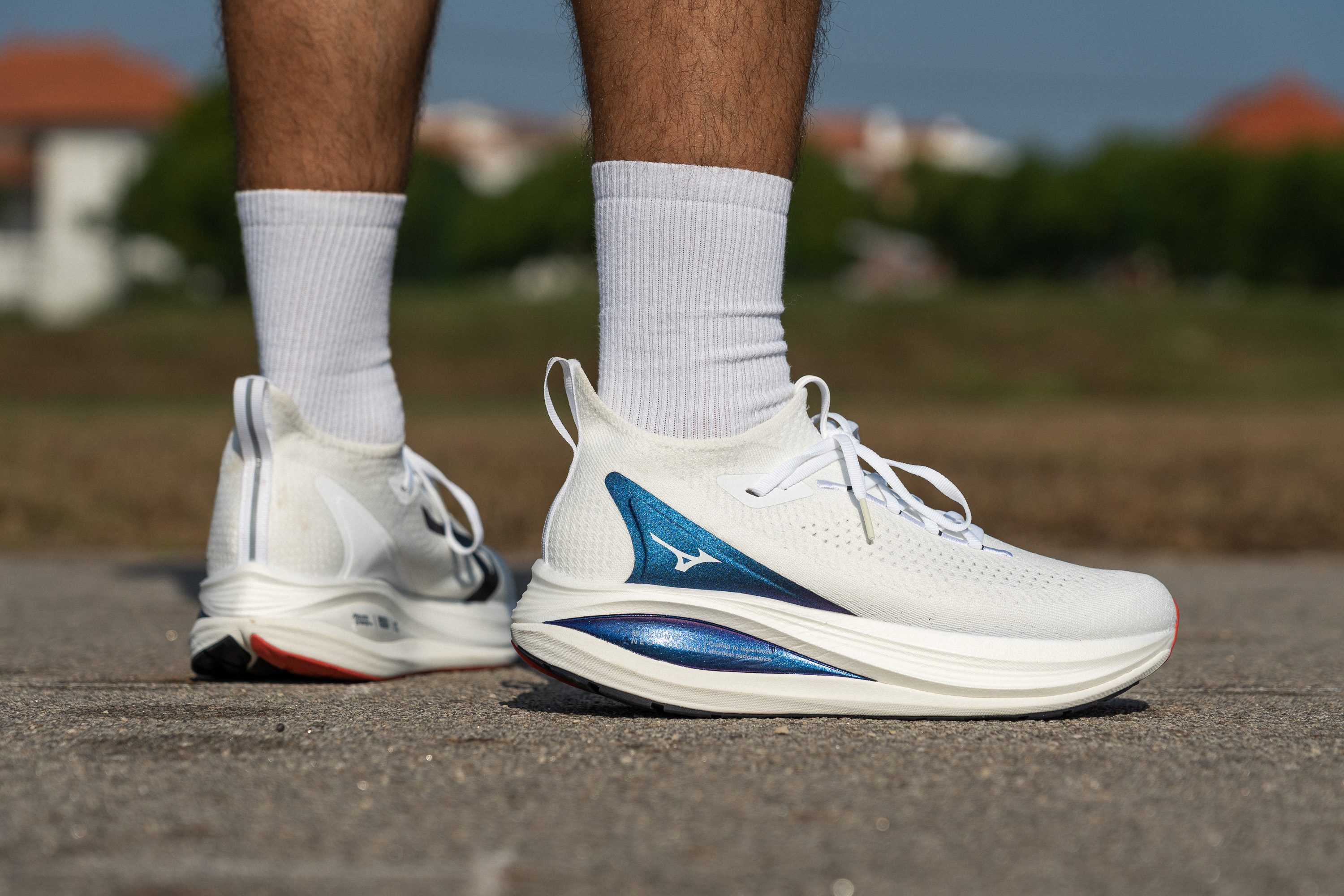
Quién NO debería comprárselas
Creemos que las Neo Vista 2 no ofrecen suficiente retorno de energía para lo que cuestan. Su espuma blandita puede ofrecer un poco de rebote, pero... nuestras pruebas de laboratorio no están muy de acuerdo. A los runners que se centran en el rendimiento les recomendamos las Saucony Endorphin Speed 5 o las Adidas Adizero EVO SL, ya que creemos que ofrecen una experiencia más interesante, además de que son modelos más económicos.
También estamos convencidos de que el hecho de que cuesten más que la v1 también puede echar para atrás a algunos corredores. Si quieres un par comodísimo que no cueste un ojo de la cara, deberías echarle un vistazo a las ASICS Novablast 5 o a las Neo Zen de Mizuno.
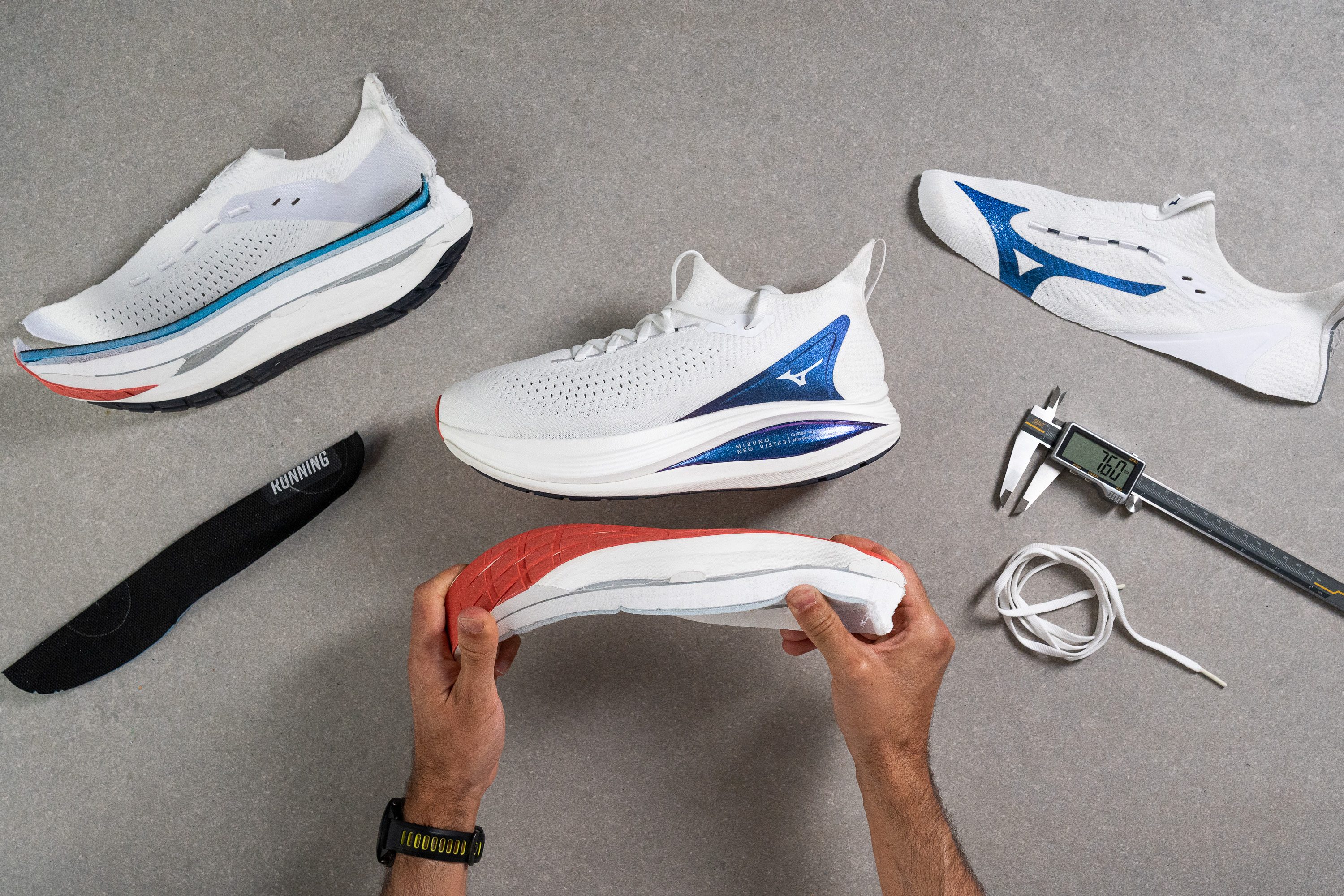
Amortiguación
Shock absorption
Cuando escribimos esta review, la primera generación de las Mizuno Neo Vista consiguió llevarse el resultado más alto en nuestra prueba de absorción de impactos con 163 SA, superando a más de 200 otros modelos (superzapatillas muy acolchadas y modelos con una estructura que parece un tanque como las Adidas Adizero Prime X3 STRUNG incluidos).
Pero Mizuno quería más. Con 170 SA en el talón y 137 SA en el antepié, la versión 2 ha vuelto incluso más fuerte con una pisada tan blandita como una almohada, llevándose la corona. La absorción de impactos de este modelo es absolutamente increíble.
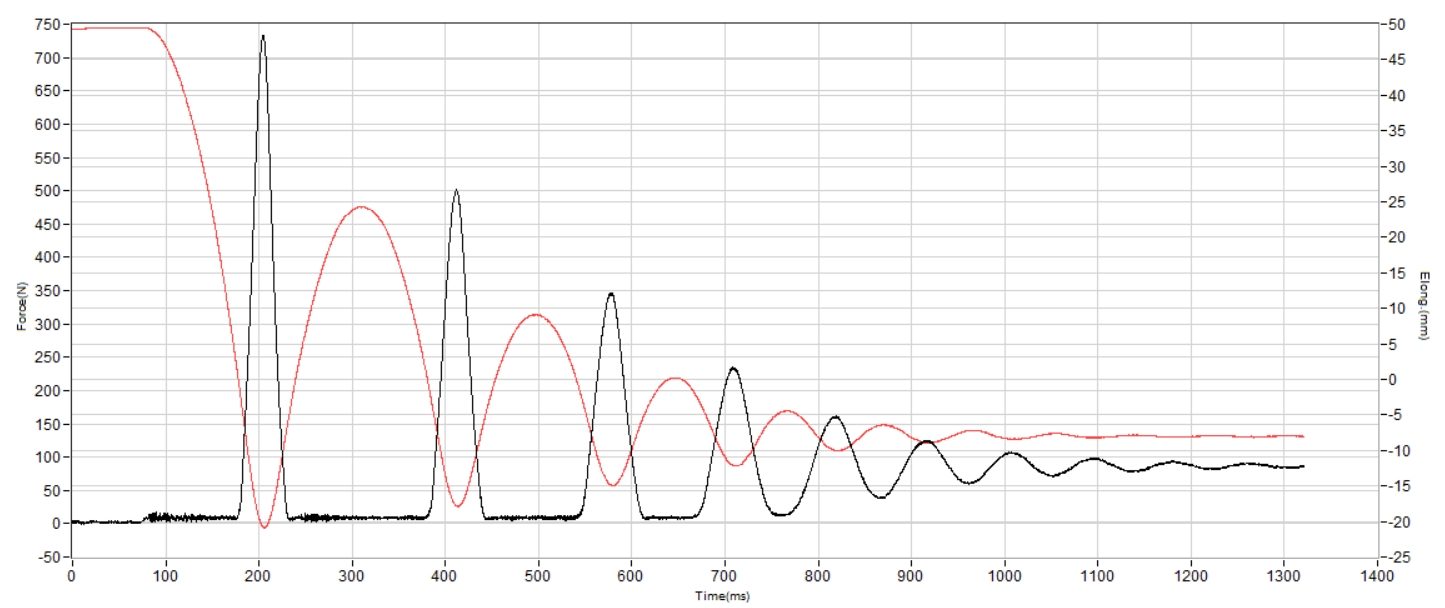
| Neo Vista 2 | 170 SA |
| Media | 129 SA |
Energy return
El retorno de energía también es mejor que el de sus predecesoras, que es un punto muy importante porque fue lo que más nos decepcionó del modelo anterior. Pero bueno, un rebote del 60,3 % tampoco es nada del otro mundo, y menos para unas zapatillas que ahora cuestan bastante más.
Eso sí, sentimos que estas Mizuno estaban llenas de energía por lo alta que es su suela y lo blandita que es su espuma, por eso es tan importante hacerle pruebas a cada modelo en el laboratorio.
| Neo Vista 2 | 60.3% |
| Media | 58.5% |
Altura de la suela en la zona del talón
Las Neo Vista 2 ofrecen un poquito más de todo en comparación con sus predecesoras, y la altura de la suela en el talón no se iba a quedar fuera. Cuando la medimos, vimos que había aumentado de 44,9 mm a 46,0 mm, así que, una vez más, son unas de las zapatillas para correr por asfalto más altas que hay en el mercado.
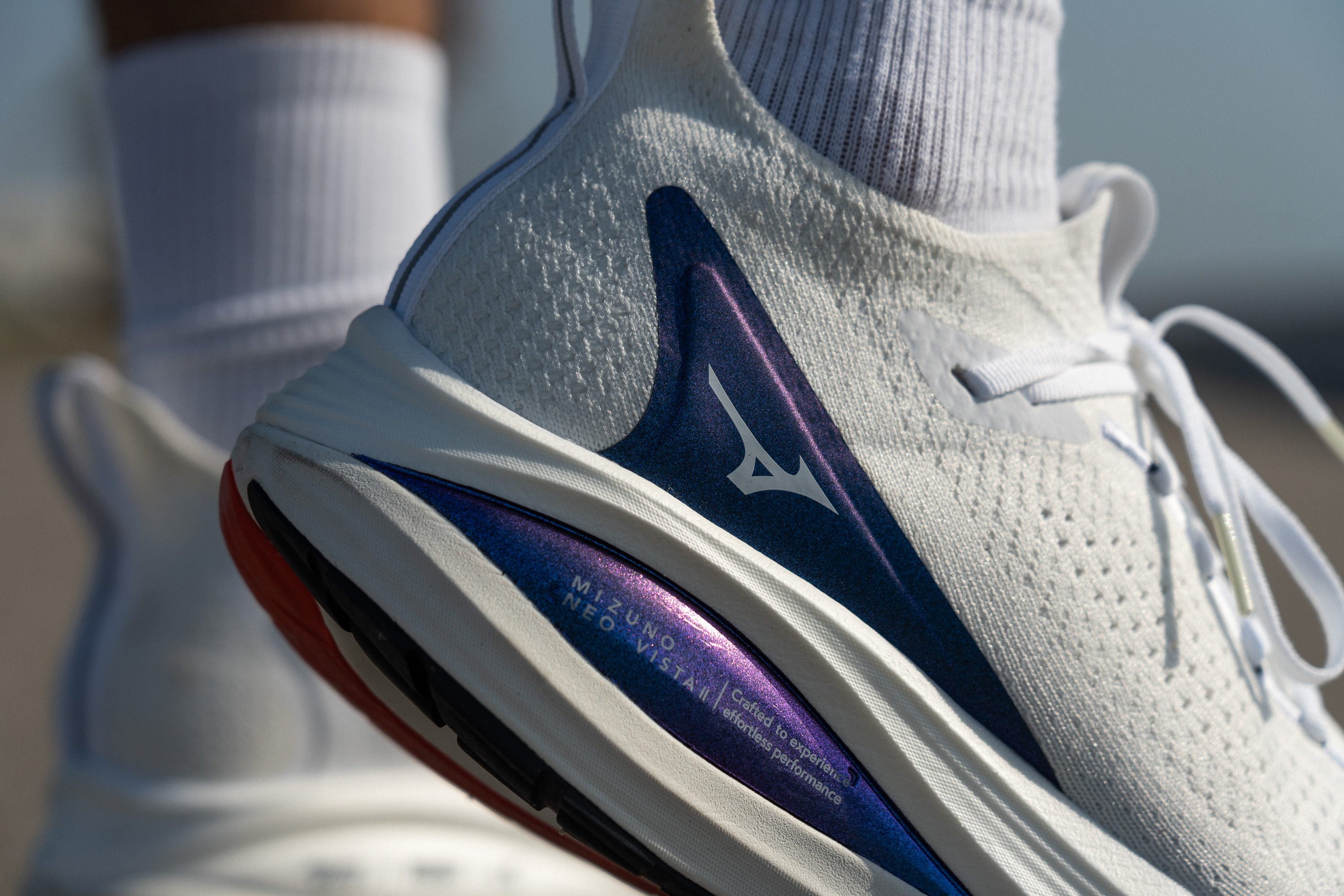
No te olvides de que, nosotros, medimos la altura de la suela en los puntos oficiales de la World Athletics, pero por el rocker de las Neo Vista 2, son un poco más gruesas en la zona del mediopié. Vamos que si estás buscando unas zapatillas de running maximalistas, creemos que hay pocas que se puedan comparar a estas, sea cual sea tu técnica de carrera.

| Neo Vista 2 | 46.0 mm |
| Media | 34.8 mm |
Altura de la suela en el antepié
El antepié también es muy alto, con 37,5 mm de espuma. Para que te hagas una idea de lo que significa esto, esa cifra lo hace más alto que la media de la altura de la suela de las zapatillas en el talón que hemos visto en nuestro laboratorio.
¡Así de imponente es! Por lo tanto, incluso con una espuma tan blandita, estas zapatillas no te van a dejar sentir el suelo bajo los pies, pero te ofrecerán una absorción de impactos excelente. Básicamente, es como correr sobre las nubes, con todos los pros y contras que eso conlleva.
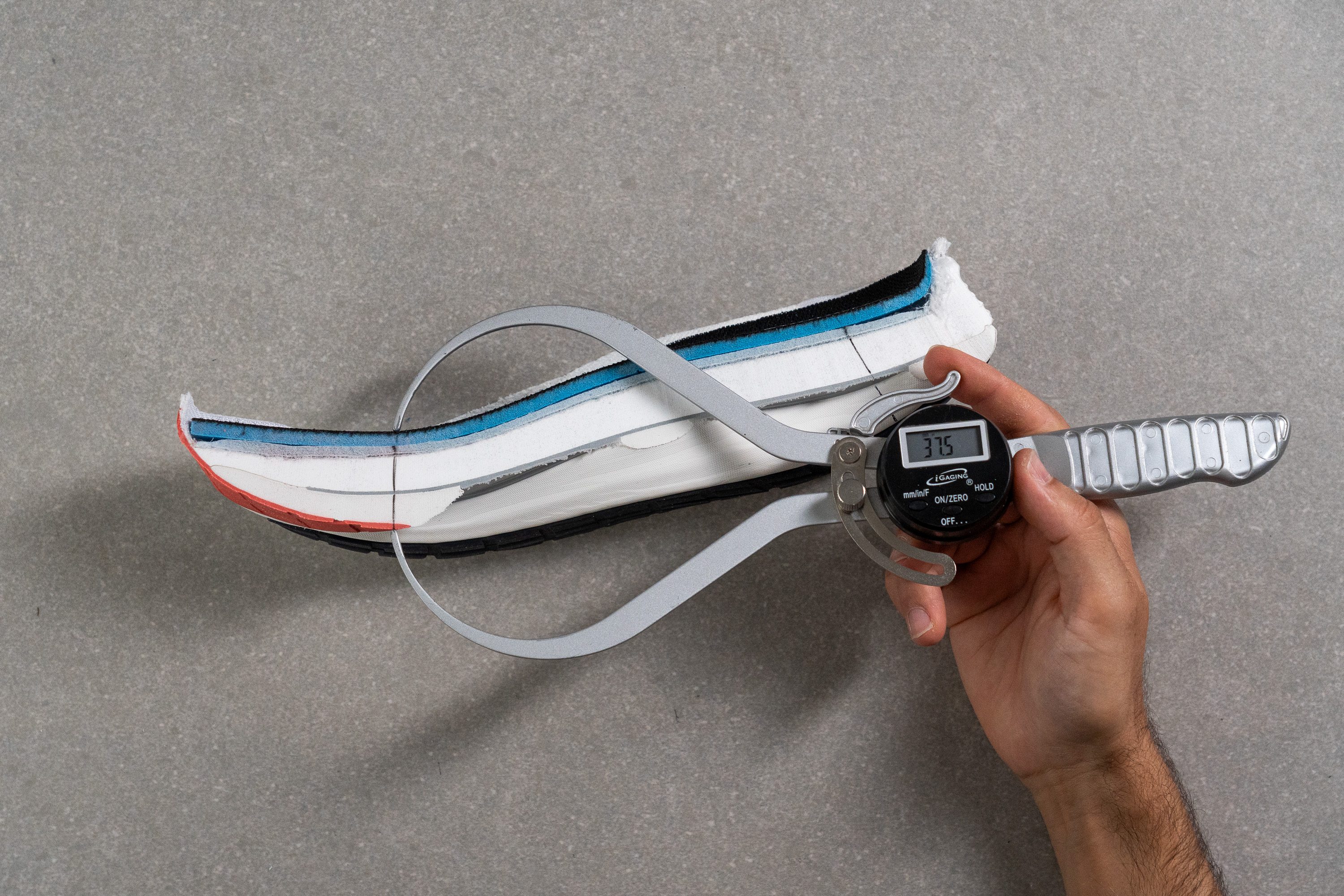
| Neo Vista 2 | 37.5 mm |
| Media | 26.2 mm |
Drop
El drop oficial de las Neo Vista es de 8 mm, y cuando lo medimos nosotros, nos dio 8,5 mm; es una diferencia aceptable que, muy probablemente, se deba a las tolerancias de fabricación.
Eso sí, estas zapatillas tienen truco. Con una estructura tan alta y una espuma tan mullida, al correr el drop se puede sentir más bajo de 8,5 mm para los talonadores, ya que la espuma se comprime tanto en el retropié que el drop se siente más bajo.
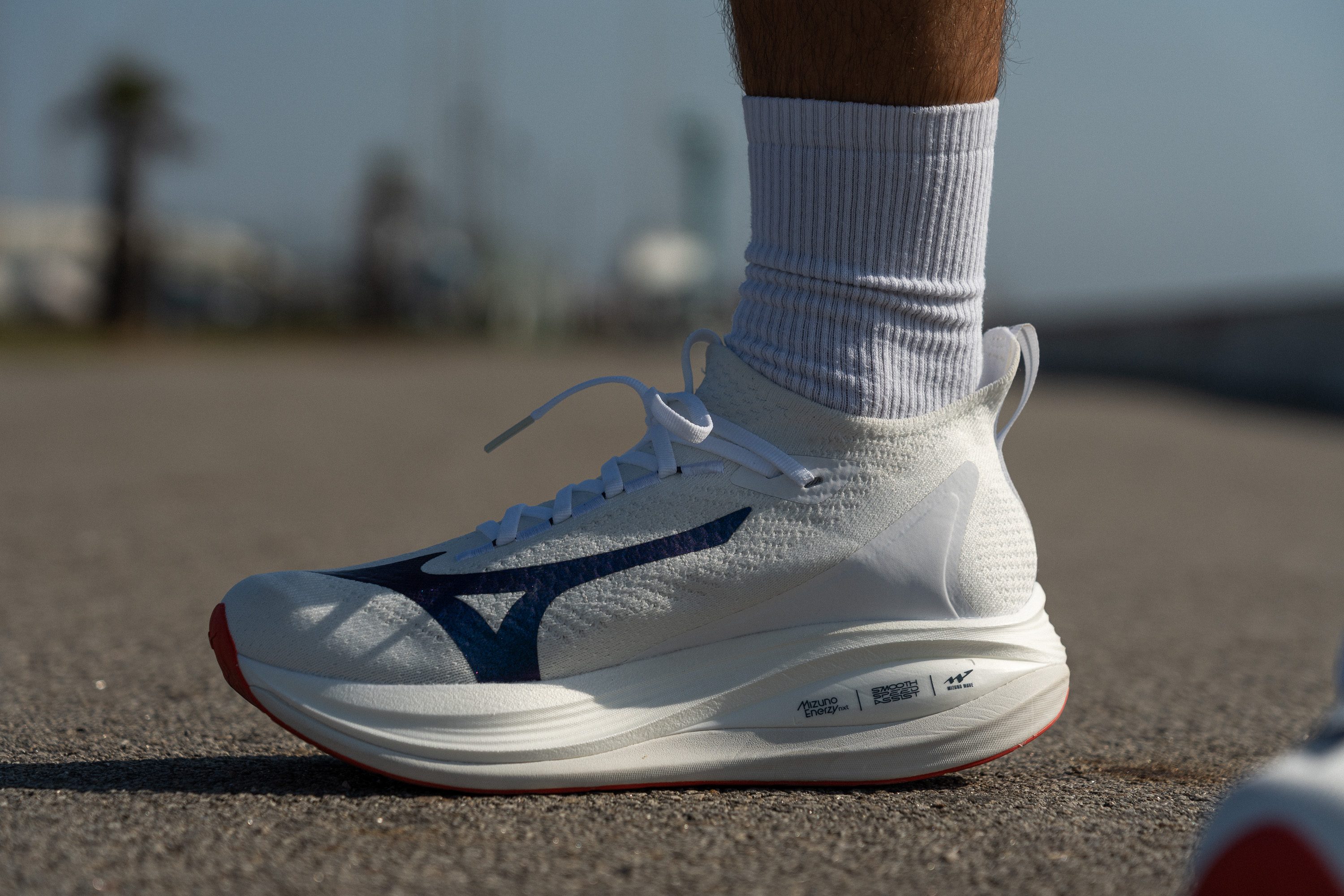
| Neo Vista 2 | 8.5 mm |
| Media | 8.6 mm |
Suavidad de la mediasuela
Ya hemos hablado de lo blandita que es la espuma de las Neo Vista 2, pero ahora vamos a profundizar un poquito más en el tema.
Estas zapatillas tienen una mediasuela de doble densidad Enerzy NXT, con la capa superior cambiando de EVA a TPU para aumentar el retorno de energía. Es una mejora positiva en general, aunque creemos que optar por PEBA en este caso habría sido todo un éxito. Pero bueno, sí estás buscando algo comodísimo y muy blandito, esta espuma cumple, ya que cuando la analizamos se llevó un resultado bajísimo de 10,0 HA en nuestro durómetro.
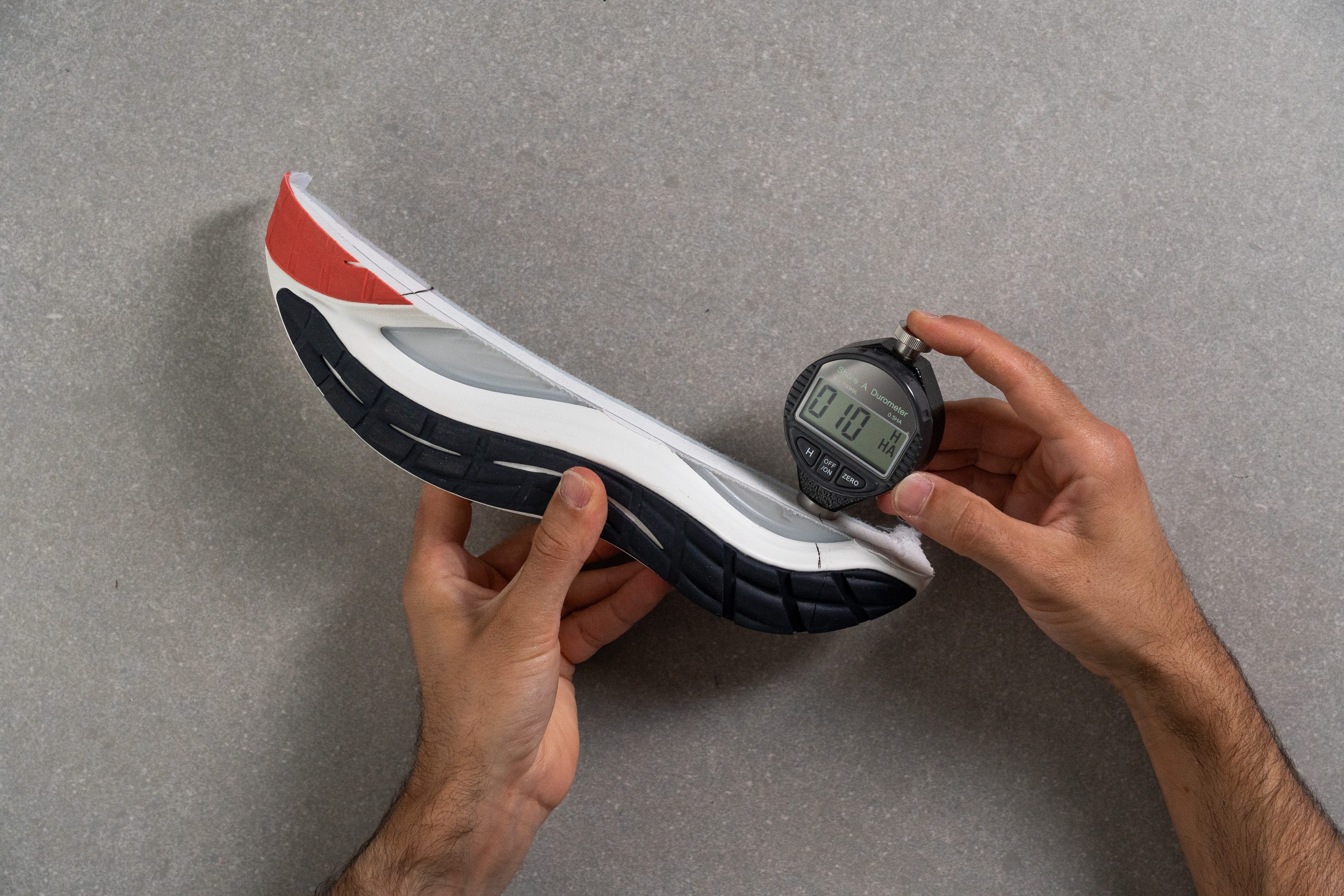
| Neo Vista 2 | 10.0 HA |
| Media | 20.4 HA |
Suavidad de la espuma secundaria
La capa secundaria está hecha de EVA, y es la principal razón por la que este modelo ofrece un retorno de energía estándar. También es mucho más firme (20,0 HA), así que proporciona más estabilidad y durabilidad.
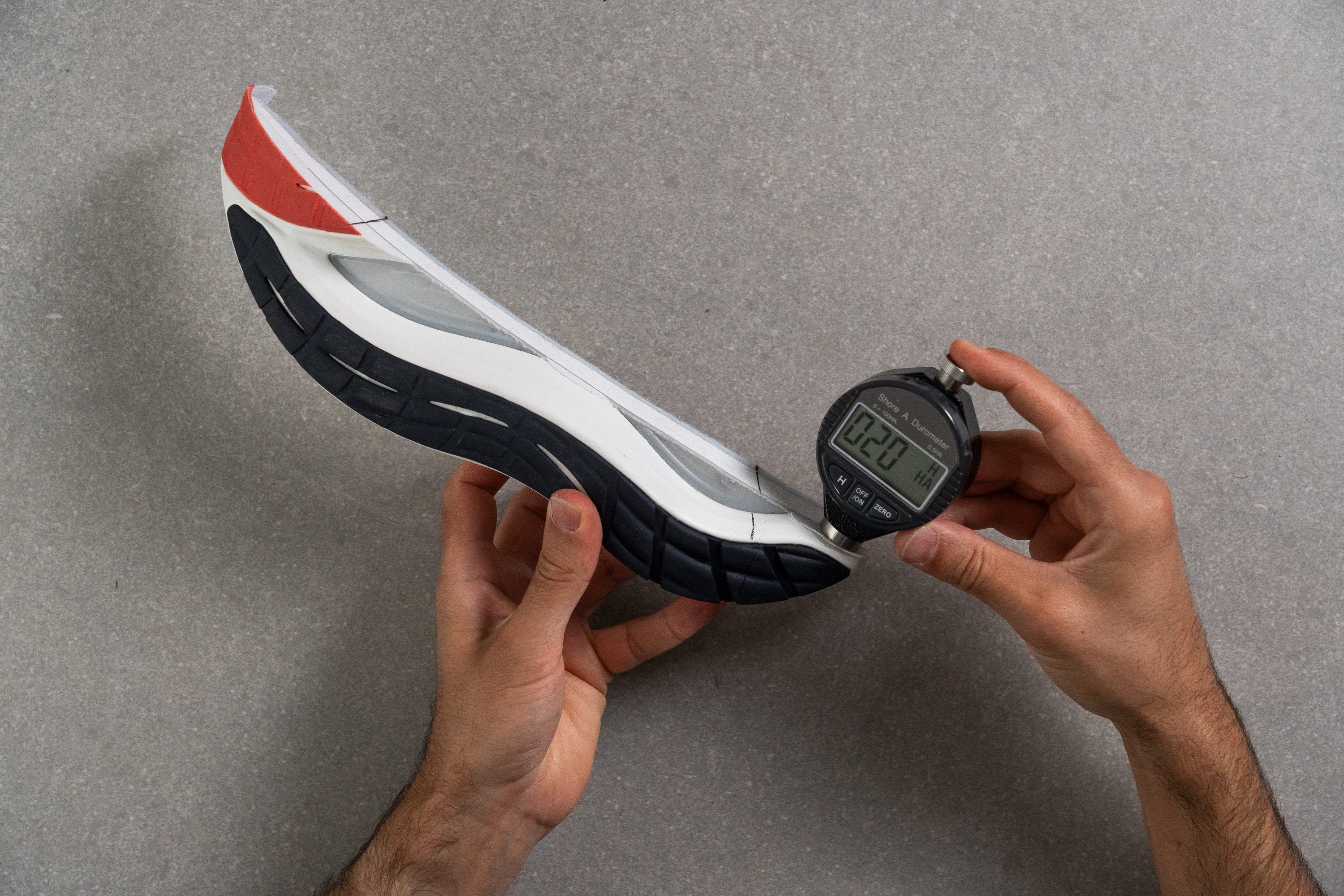
| Neo Vista 2 | 20.0 HA |
| Media | 22.7 HA |
Rocker
Las Mizuno Neo Vista 2 tienen un rocker que es clave por lo altísimas que son tanto en el talón (46,0 mm) como en el antepié (37,5 mm). El rocker empieza a los 8 cm en el antepié y es muy gradual, por lo que crea una sensación suave que ayuda a que la espuma mullida de las zapatillas tenga más energía en los despegues.
También vimos que el biselado del talón es pronunciado, lo que nos parece clave para ayudar a los talonadores a disfrutar de una mejor experiencia. De lo contrario, la combinación de una espuma blandita y una suela alta en el talón puede hacer que las transiciones sean lentas.
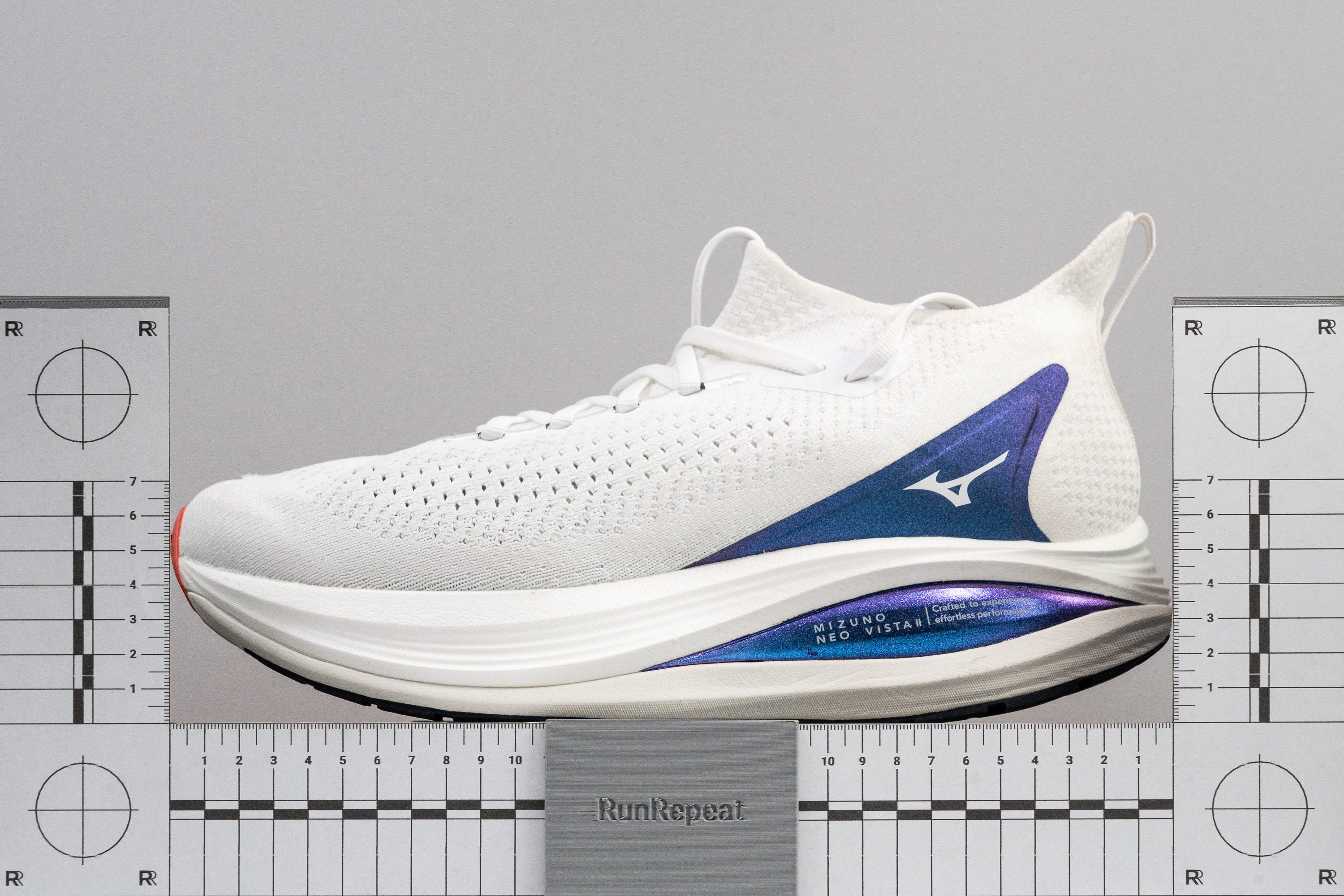
Placa
Nos volvimos a encontrar con la misma Wave Plate de fibra de vidrio que funcionó tan bien en las primeras Neo Vista. Es clave para estabilizar el pie en cada aterrizaje y añadir un poco de impulso, pero no te esperes una sensación como la de las placas carbono, ya que esta no hace que las zapatillas sean muy rígidas.
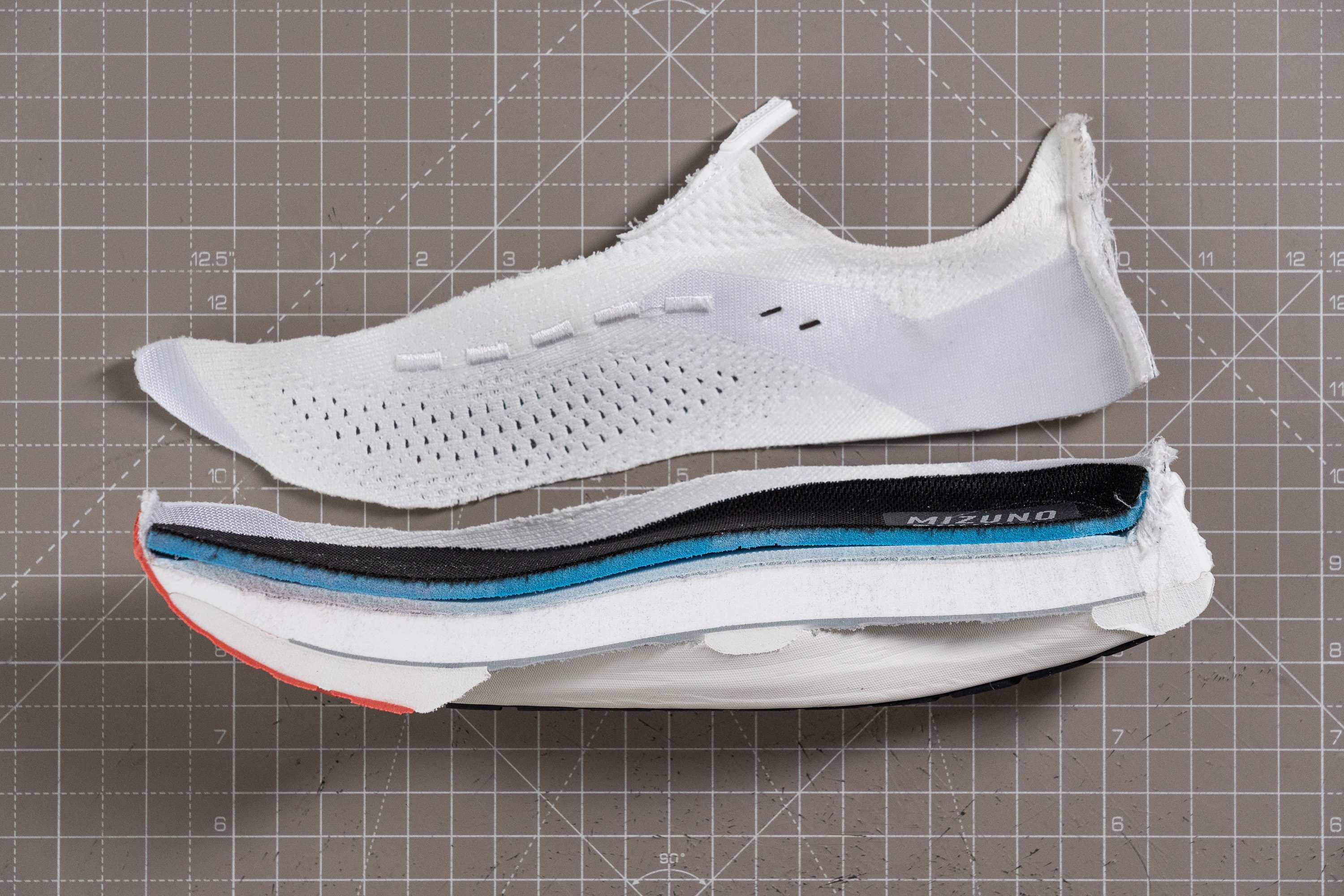
Tallaje y ajuste
Talla
Las Mizuno Neo Vista 2 son media talla más grandes (59 votos).
Plantéate bajar media talla
Anchura / Ajuste
El ajuste de las Neo Vista 2 es un tema muy interesante, porque los uppers de knit a veces pueden ser engañosos por lo que dan de sí, así que al final ofrecen más espacio del que parece. Pero el upper de estas Mizuno no es demasiado elástico, así que actúa como una malla estándar.
En su punto más ancho, miden 96,5 mm, lo que indica un ajuste estándar con un poco más de espacio de lo que normalmente encontrarías en unas zapatillas de entrenamiento diario.
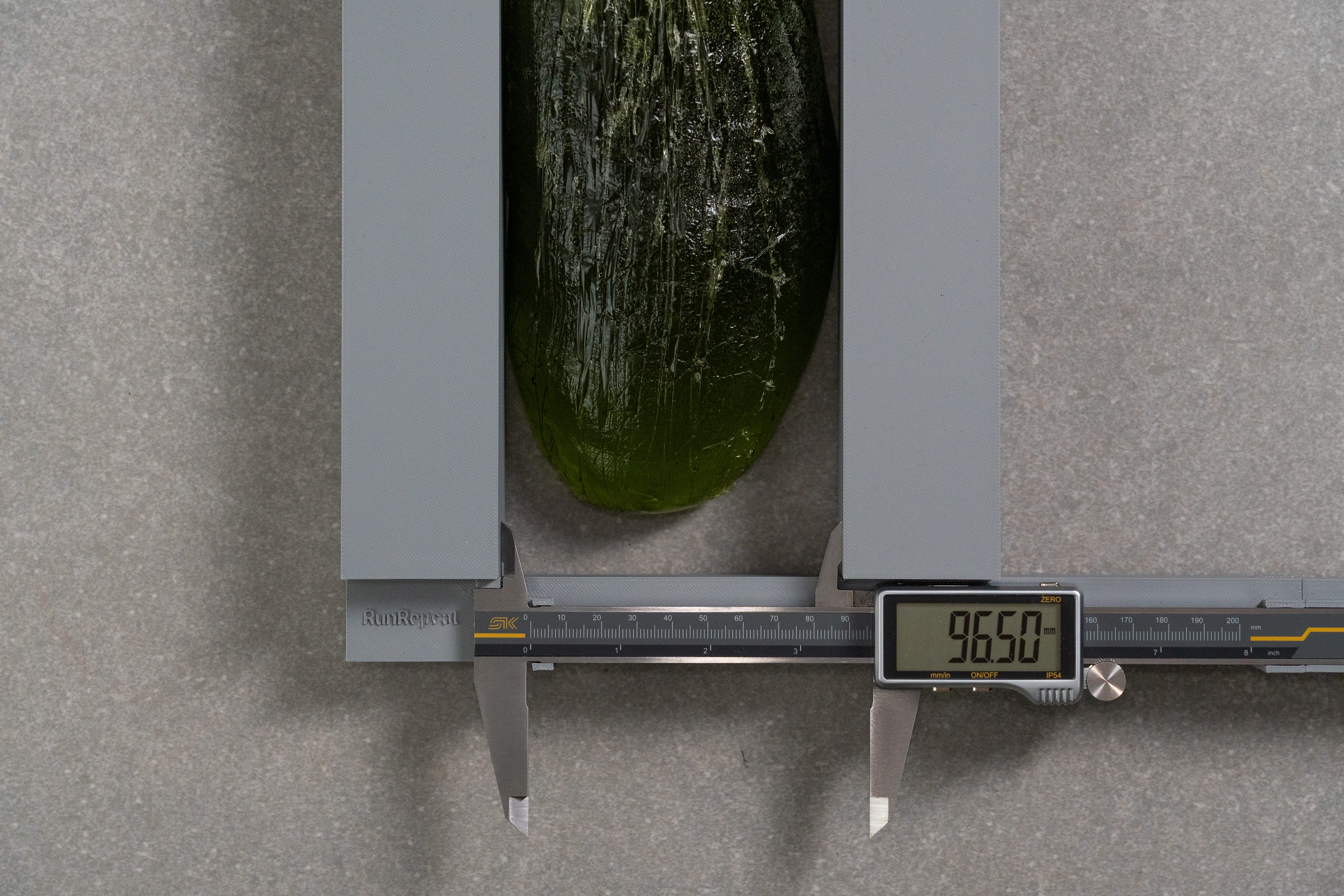
| Neo Vista 2 | 96.5 mm |
| Media | 95.1 mm |
Anchura de la parte delantera
Ahora la parte delantera mide 72,9 mm, lo que la hace más estrecha que los 74,6 mm de la versión 1. Y aunque es cierto que el material se adapta un poco a los dedos gracias a la falta de refuerzos o costuras, no te esperes que estas zapatillas se adapten a los pies anchos.
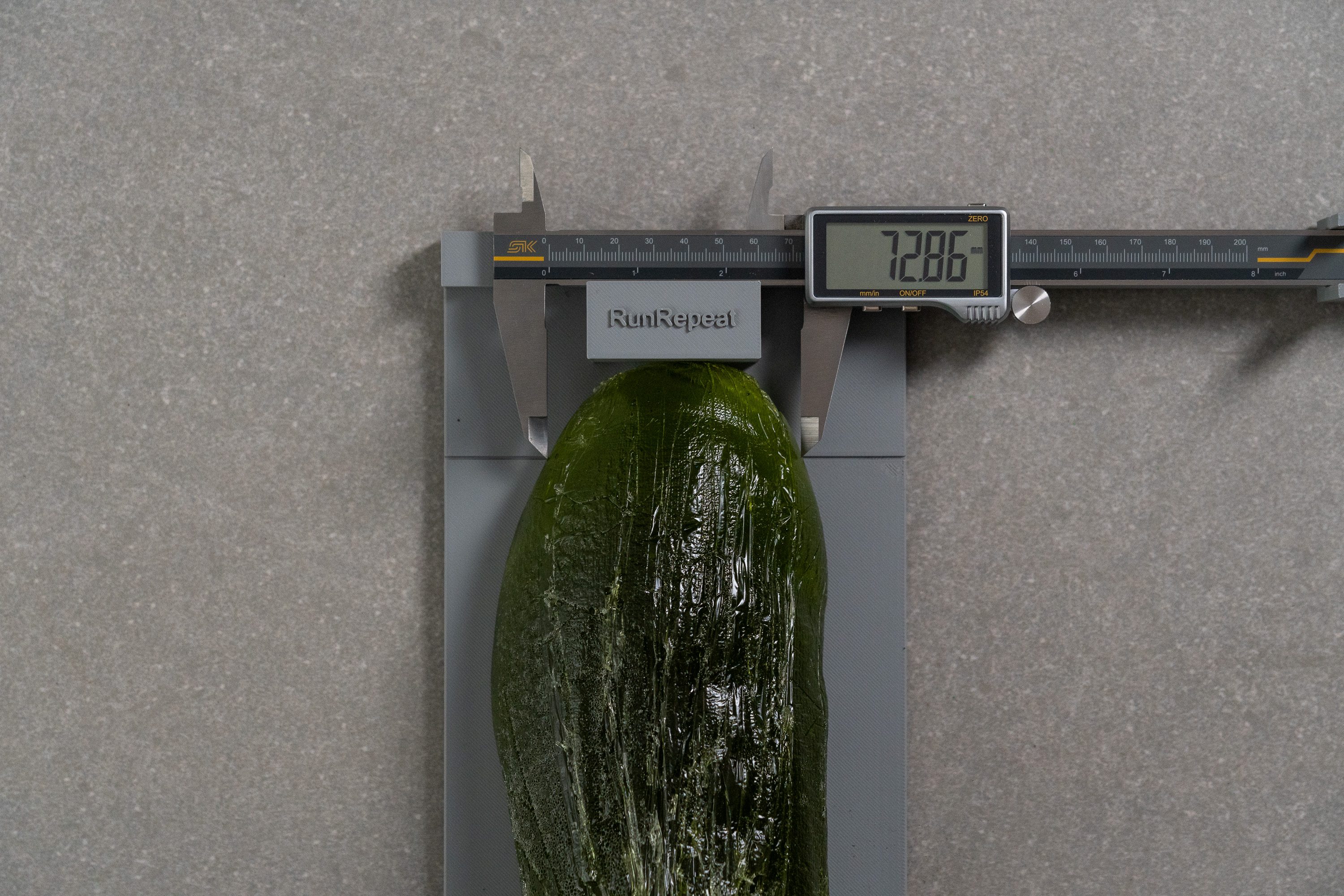
| Neo Vista 2 | 72.9 mm |
| Media | 73.2 mm |
Altura de la parte delantera
Por otro lado, ofrecen altura de sobra en la zona de los dedos, alcanzando un espacio vertical de 29,2 mm. Esto es ideal para los corredores a los que no les gusta sentir presión en los dedos, aunque a los que prefieren un ajuste ceñido y seguro puede que las Neo Vista 2 les parezcan un poco holgadas.
La versión 1 solo alcanzaba 25,7 mm en esta zona, así que esta actualización sin duda se centra en la comodidad.
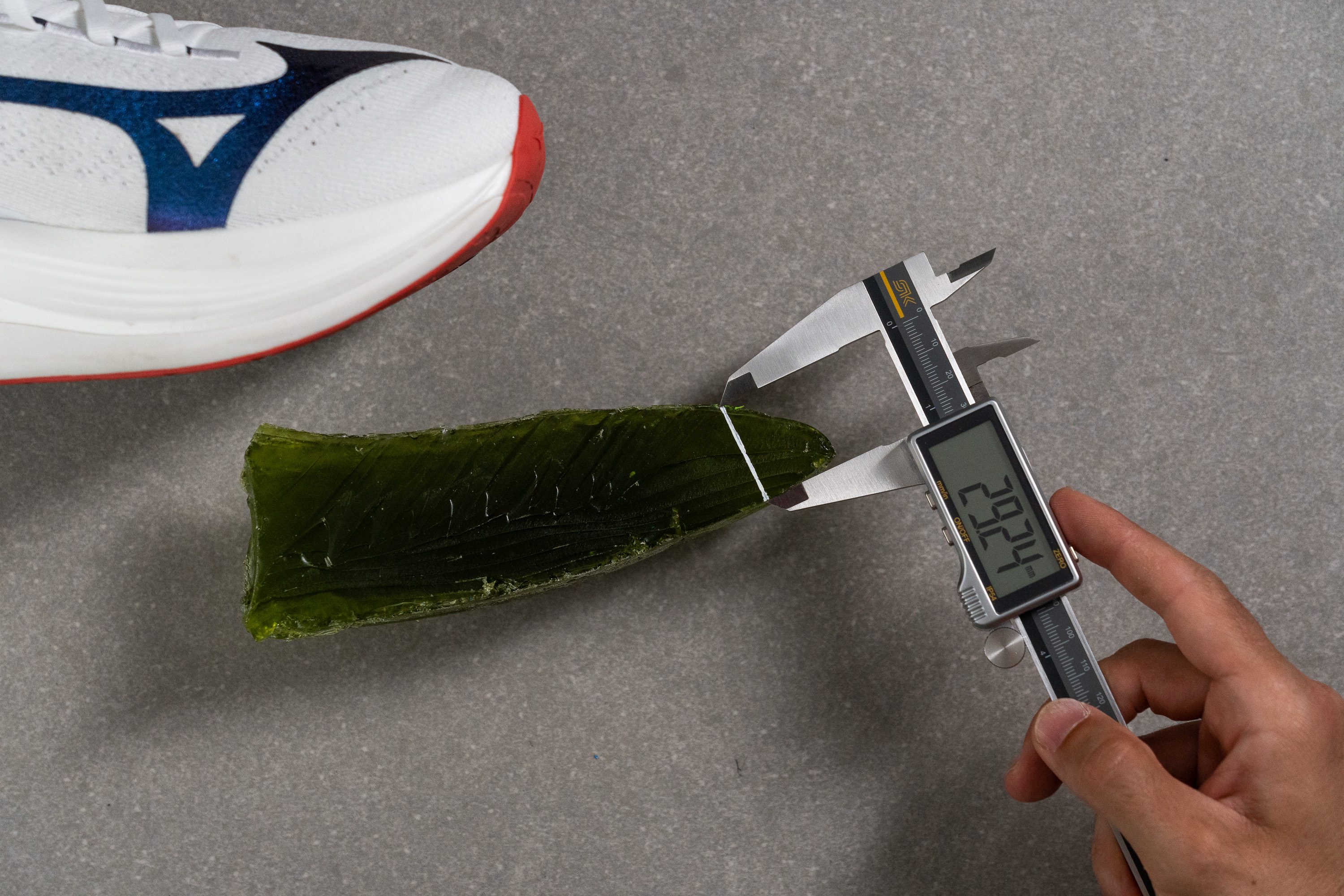
| Neo Vista 2 | 29.2 mm |
| Media | 27.1 mm |
Tracción / Agarre
Traction test
Mizuno utilizó su caucho X10 en las Neo Vista 2 como parte de las actualizaciones para esta segunda versión, y eso trajo una ligera mejora en el agarre. Ahora se llevaron un 0,45 en nuestra prueba de tracción sobre asfalto mojado, un resultado sólido que confirma un buen agarre tanto en superficies secas como mojadas. Eso sí, sinceramente, nos esperábamos un poco más por su precio.
| Neo Vista 2 | 0.45 |
| Media | 0.48 |
Diseño de la suela exterior
La suela exterior de las Mizuno Neo Vista 2 tiene segmentos de caucho X10 rojos y negros que cubren completamente el antepié, el mediopié y el talón. Estas zonas están separadas por un gran corte que atraviesa el centro, lo que ayuda a reducir el peso y a aumentar la flexibilidad en esta zona.
Una actualización clave en el diseño es el corte que tienen en el mediopié, que ahora está dividido en dos zonas en vez de en una.
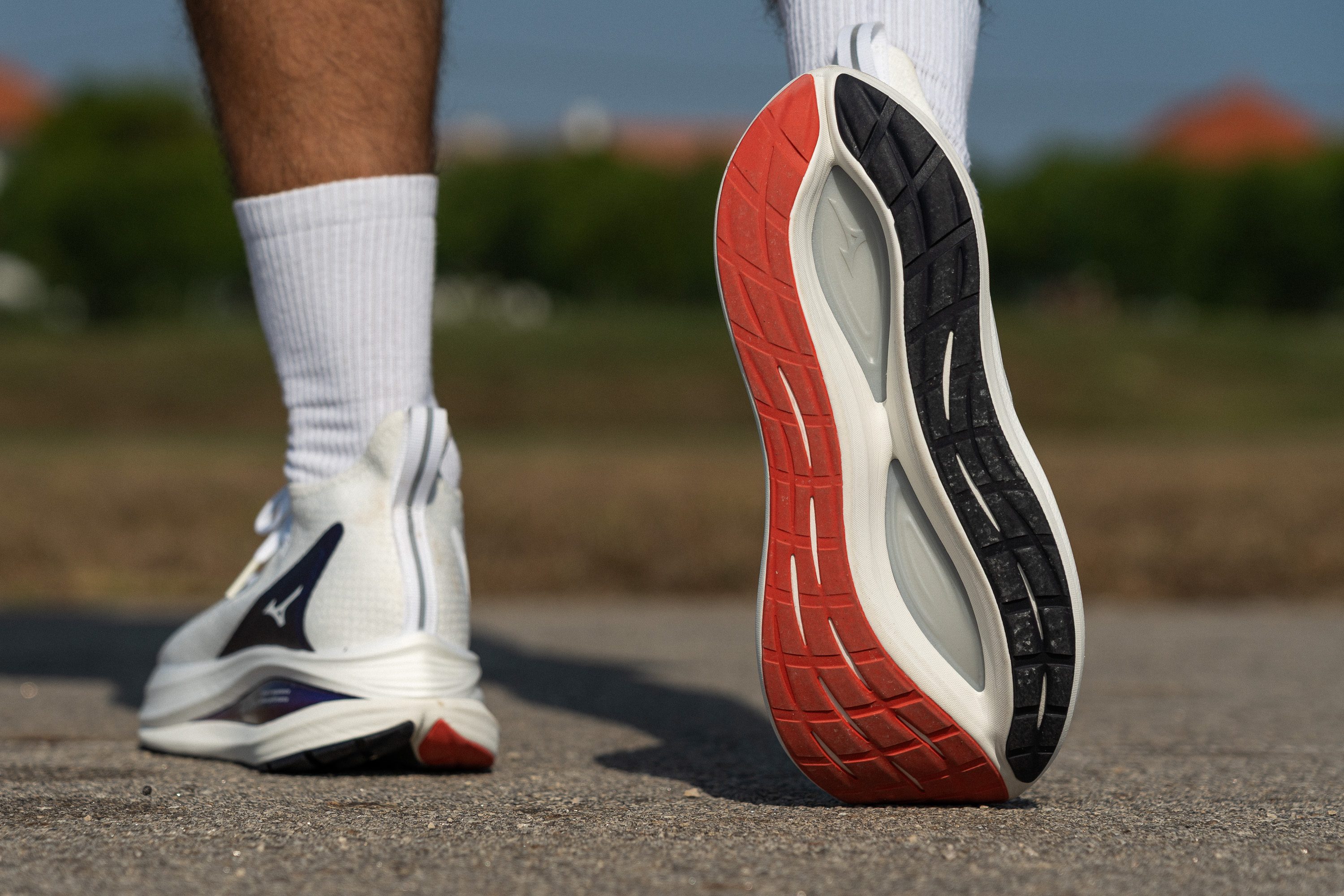
Flexibilidad / Rigidez
Estamos muy contentos de que Mizuno haya mantenido la placa de fibra de vidrio en lugar de cambiarla por una de carbono, porque esto habría arruinado la comodidad para las tiradas diarias. De hecho, este modelo se llevó una puntuación más baja que la media en nuestra prueba de flexión de 30 grados con solo 13,5 N.
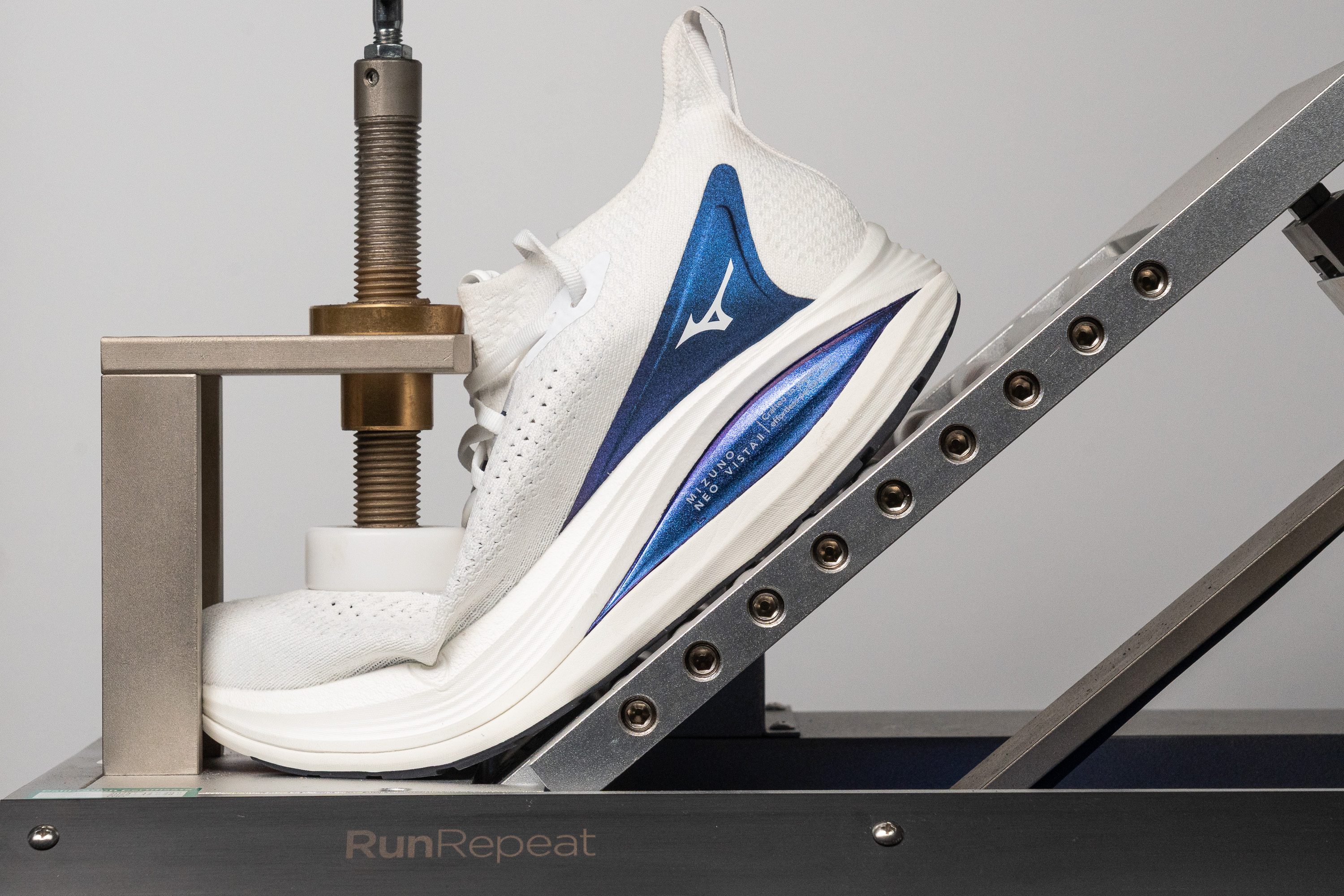
| Neo Vista 2 | 13.5N |
| Media | 15.3N |
Peso
La v2 pesa un poquito más que la v1, ya que de 259 g pasa a 264 g. Pero es un aumento tan pequeñito que no se nota, y las zapatillas lo justifican con una suela y mediasuela más grandotas. Además, sigue siendo un resultado estupendo para unas zapatillas de running tan altas y con tanta amortiguación.
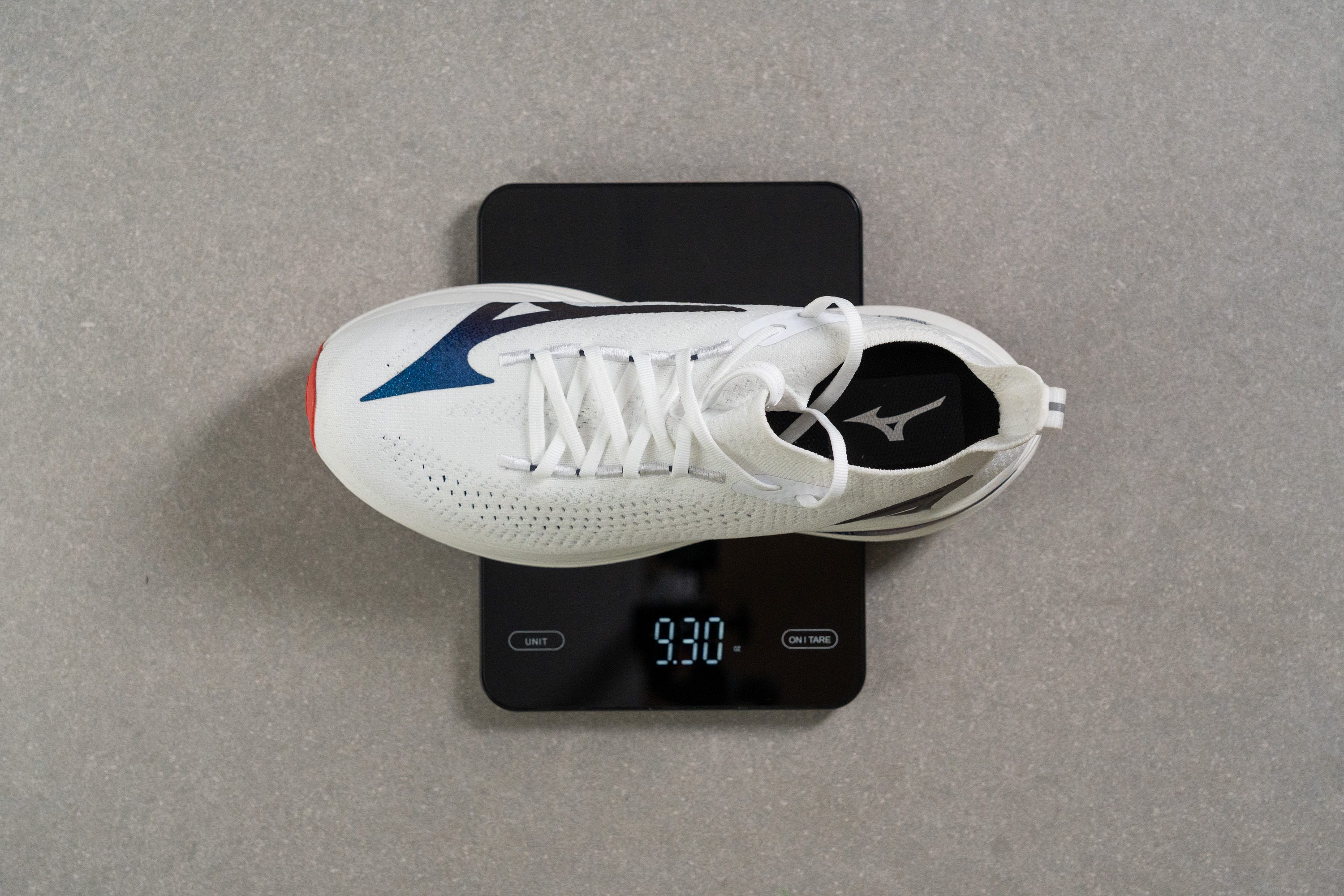
| Neo Vista 2 | 9.3 oz (264g) |
| Media | 9.3 oz (264g) |
Transpirabilidad
Las OG Neo Vista les gustaron a prácticamente todos los corredores, pero los que salen a hacer deporte cuando hace calor no estaban tan contentos con ellas. Su upper es demasiado denso, así que no ofrece un buen flujo de aire.
Por suerte, Mizuno trajo el diseño de las Neo Zen a este modelo, mejorando su transpirabilidad. Se llevaron un 4/5 en esta prueba, así que son ideales para cualquier estación o temperatura.
Es fácil entender por qué la transpirabilidad ha mejorado. El upper de knit, que es de una sola pieza, ahora tiene montones de agujeritos para que el aire entre y salga, ayudando a reducir la temperatura dentro de las zapatillas.
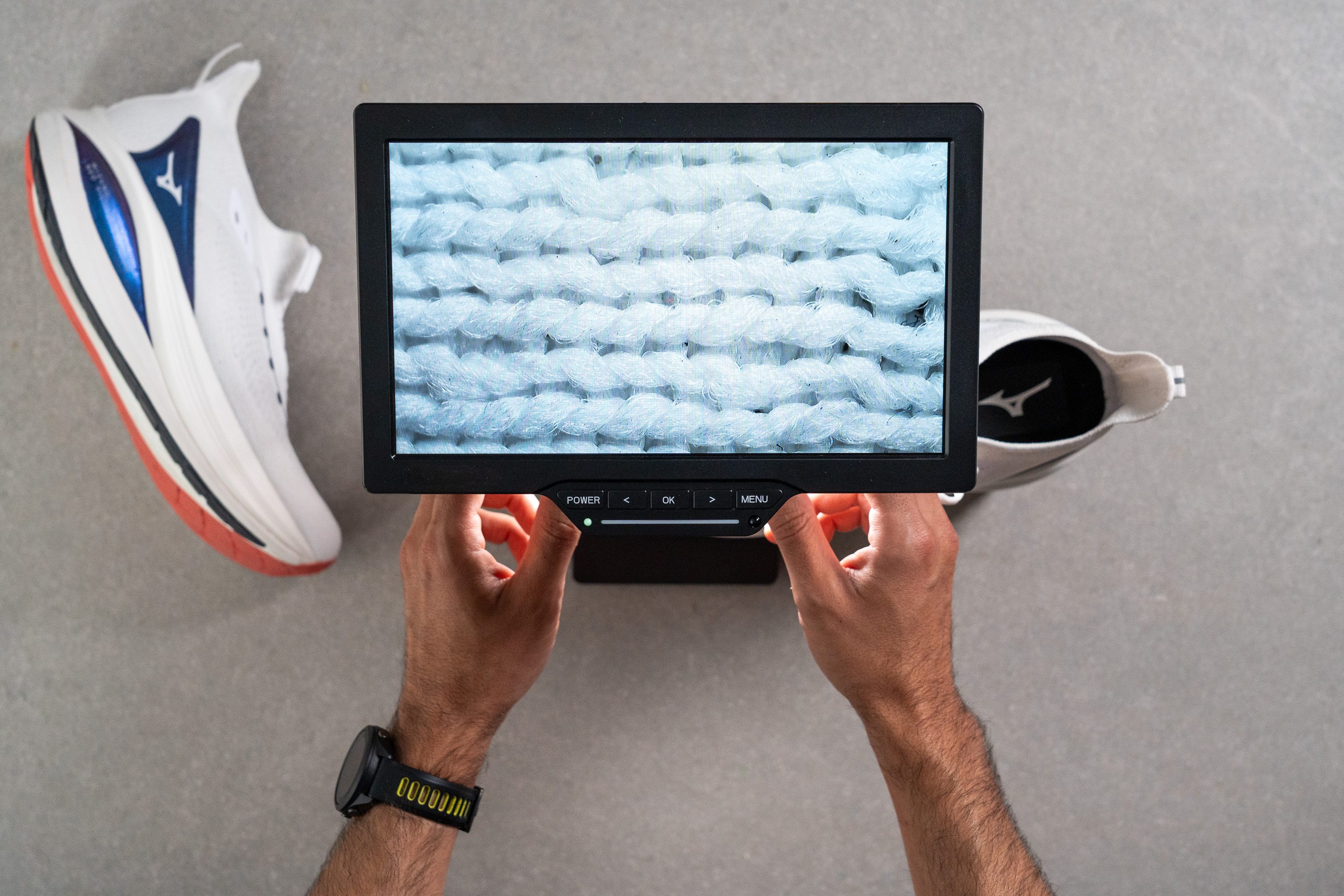
El knit sigue siendo grueso y protector, como confirmamos bajo el microscopio. Esto destaca lo importantísimos que son los agujeritos para el flujo de aire, que ayudan a que las zapatillas expulsen el calor de manera efectiva.
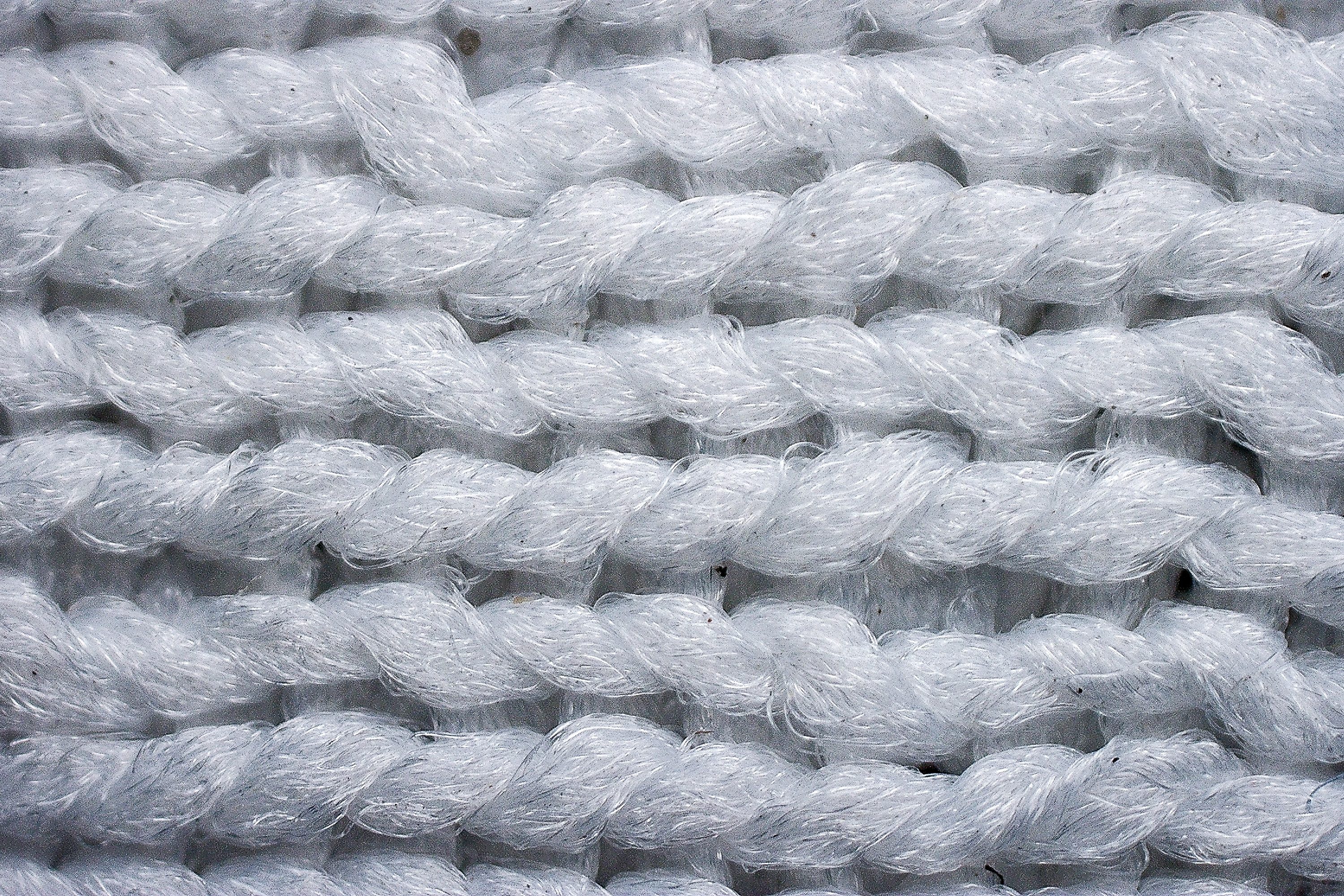
Creemos que este upper les va a encantar a los corredores a los que les gustan los modelos con knit pero que no aguantan las costuras. Es simple pero efectivo, y los materiales que utiliza Mizuno hicieron que sintiésemos confianza, estando a la altura del precio de estas zapatillas.
| Neo Vista 2 | 4 |
| Media | 3.7 |
Estabilidad
Prueba de estabilidad lateral
Las Neo Vista 2 son unas zapatillas de running neutras, así que no se las recomendamos a las personas que están buscando estabilidad en unas superzapatillas de entrenamiento. En ese caso, las ASICS Superblast 2 son una mejor opción.
Las NV2 son demasiado blanditas para las personas que tienen problemas de pronación, y solo ofrece una pisada suave cuando aterrizas en línea recta. De hecho, coger curvas es un poco arriesgado, incluso con esos refuerzos de TPU alrededor de los lados del talón.
Rigidez torsional
La placa Wave de nylon desempeña un papel clave al hacer que las zapatillas se sientan rígidas. En nuestra prueba de laboratorio, la rigidez torsional aumentó hasta alcanzar un sólido 4/5.
| Neo Vista 2 | 4 |
| Media | 3.5 |
Rigidez del contrafuerte del talón
Por el contrario, el contrafuerte del talón se llevó solo un 1/5. Como pasa con muchos uppers tipo calcetín de knit, le falta estructura, así que los corredores que necesitan un extra de estabilidad en esta zona a lo mejor prefieren un diseño más tradicional.
Eso sí, es comodísimo y una opción estupenda para las personas que tienen el tendón de Aquiles sensible.
| Neo Vista 2 | 1 |
| Media | 2.9 |
Anchura de la mediasuela - antepié
Nos sorprendió ver que Mizuno redujo el ancho de la mediasuela en el antepié de 120,8 mm a 116,4 mm.
No nos pareció una mala idea, ya que esto hace que las zapatillas se sientan más ágiles, lo que es ideal para ir a un ritmo rápido. Este cambio también se debe a que el corte central es más estrecho en comparación con el de la versión 1, lo que claramente cambia la forma de la plataforma bajo los pies.
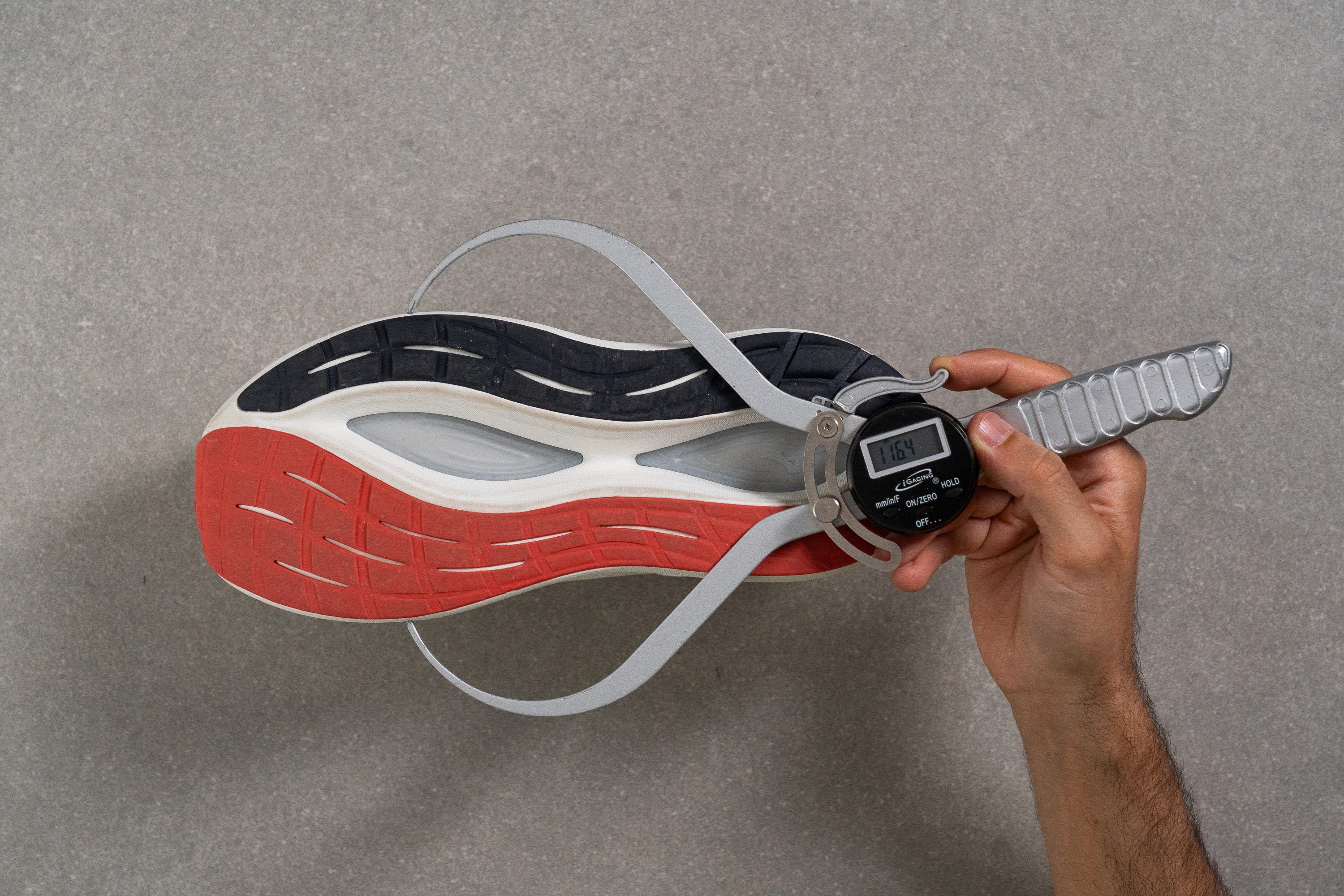
| Neo Vista 2 | 116.4 mm |
| Media | 114.4 mm |
Anchura de la mediasuela - talón
Al talón le pasó lo mismo, ya que pasa de 97,9 mm a 95,8 mm. De todos modos, sigue siendo mucho más ancho que la media, un ajuste necesario para proporcionar la estabilidad necesaria teniendo en cuenta lo altísimas que son las Neo Vista 2.
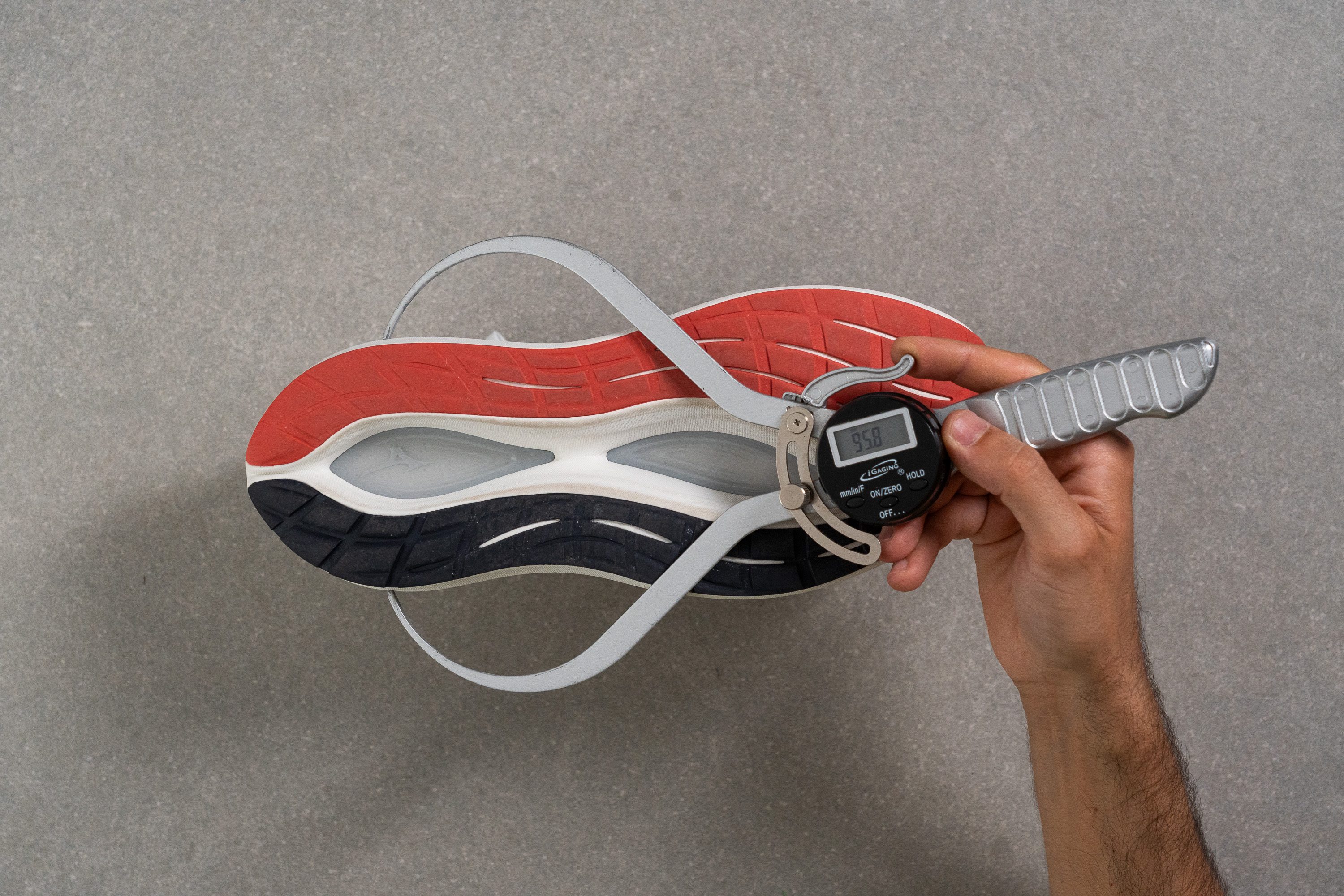
| Neo Vista 2 | 95.8 mm |
| Media | 90.7 mm |
Durabilidad
Durabilidad de la parte delantera
El knit utilizado por Mizuno demostró una durabilidad excelente en nuestra Dremel al llevarse la máxima puntuación: un 5/5. Si a esto le sumamos lo alta que es su parte delantera, creemos que va a ser muy, pero que muy difícil que los corredores desgasten esta área.
| Neo Vista 2 | 5 |
| Media | 2.6 |
Durabilidad del acolchado del talón
Que no tengan acolchado en el talón fue justo lo que hizo que las Neo Vista 2 se pudiesen llevar un maravilloso 4/5 en nuestra prueba de durabilidad en esta zona, superando fácilmente a la media.
| Neo Vista 2 | 4 |
| Media | 3.4 |
Durabilidad de la suela
Volvimos a encender el Dremel en el laboratorio para probar la dureza del caucho X10, y resulta que este compuesto japonés es muy resistente. ¡Solo se desgastó 0,6 mm!
| Neo Vista 2 | 0.6 mm |
| Media | 1.1 mm |
Grosor de la suela
Las Neo Vista 2 tienen 3,5 mm de caucho X10 en el talón, ofreciendo una excelente protección en esta área y dejando en claro que no se van a desgastar antes de tiempo... ¡incluso si impactas fuerte con el talón!
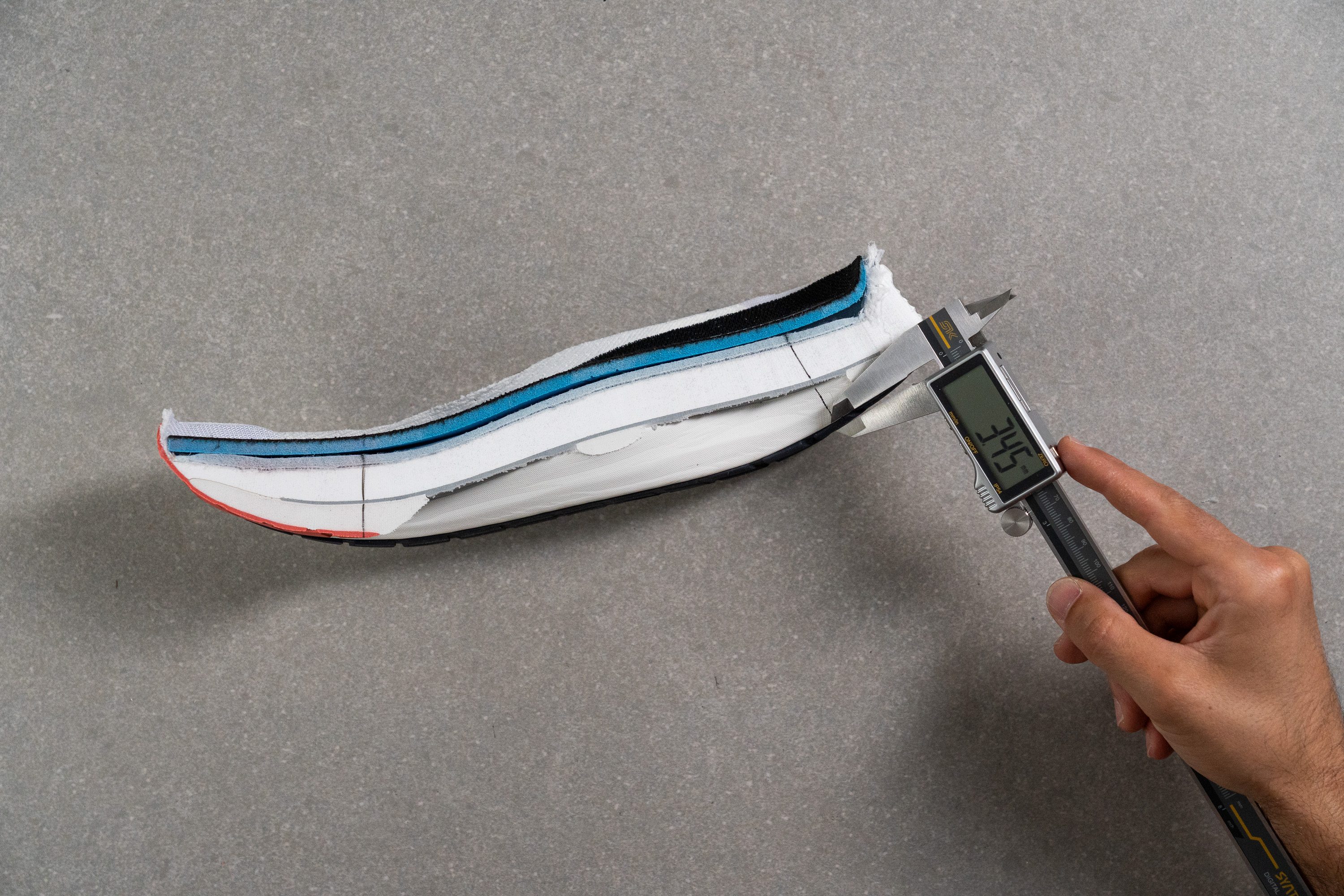
| Neo Vista 2 | 3.5 mm |
| Media | 3.2 mm |
Grosor de la suela (parte delantera)
La diferencia en el grosor del caucho desde el talón hasta el antepié suele ser mínima en la mayoría de las zapatillas de running, ¡pero no en las Neo Vista 2!
Mizuno utilizó solo 1,70 mm en la parte delantera, que es una estrategia interesante para reducir el peso. Y aunque la capa de esta parte delantera es más finita, creemos que el caucho X10 está listo para aguantar lo que le eches, como demostraron los resultados de nuestra prueba Dremel.
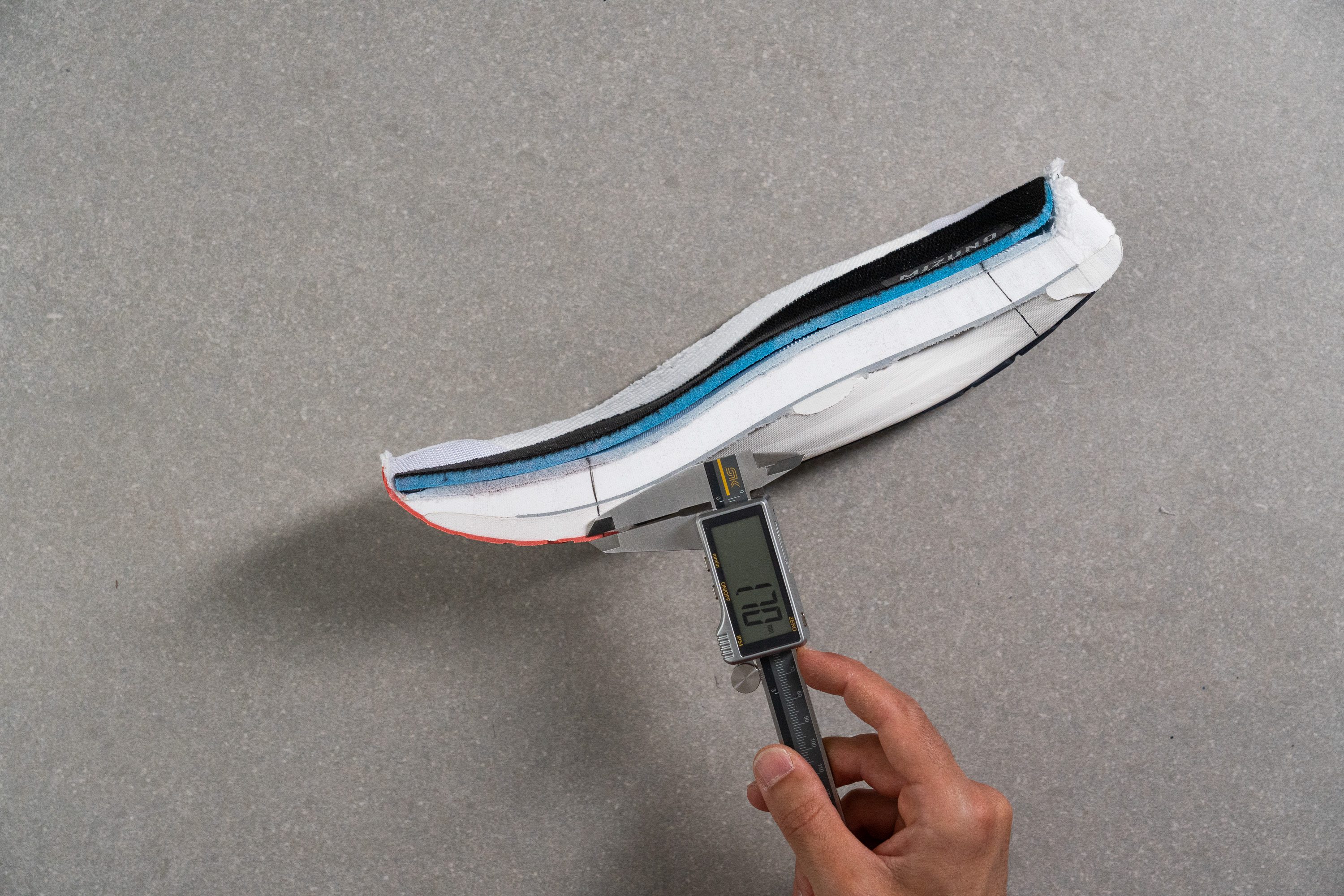
Varios
Grosor de la plantilla
La plantilla le añade 4,8 mm de amortiguación a la mediasuela, que es aproximadamente la media. Esta es una de las pocas cosas en la que las Neo Vista 2 no destacan.
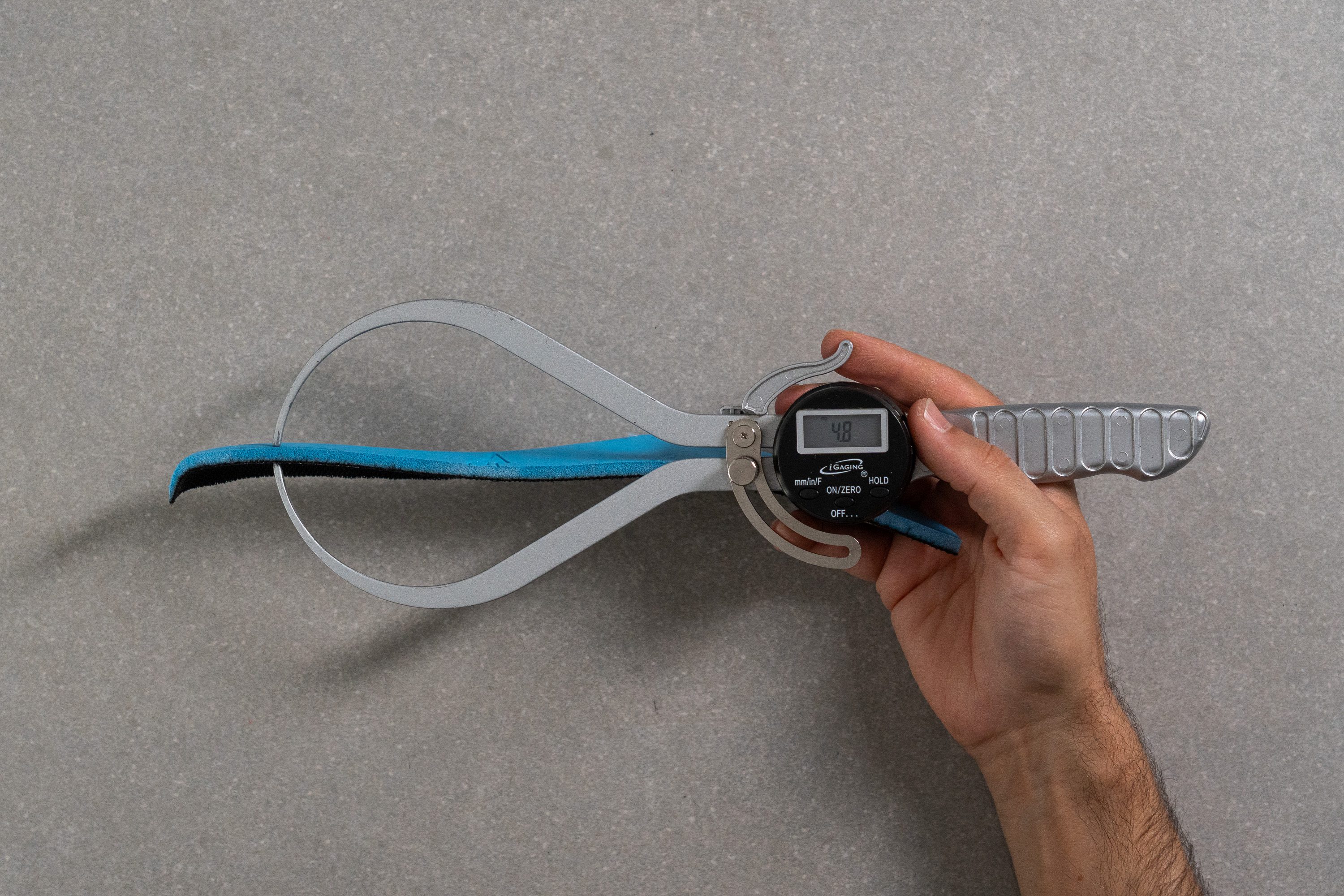
| Neo Vista 2 | 4.8 mm |
| Media | 4.5 mm |
Plantilla extraíble
La plantilla es completamente extraíble, así que si la quieres cambiar no tendrás problema.
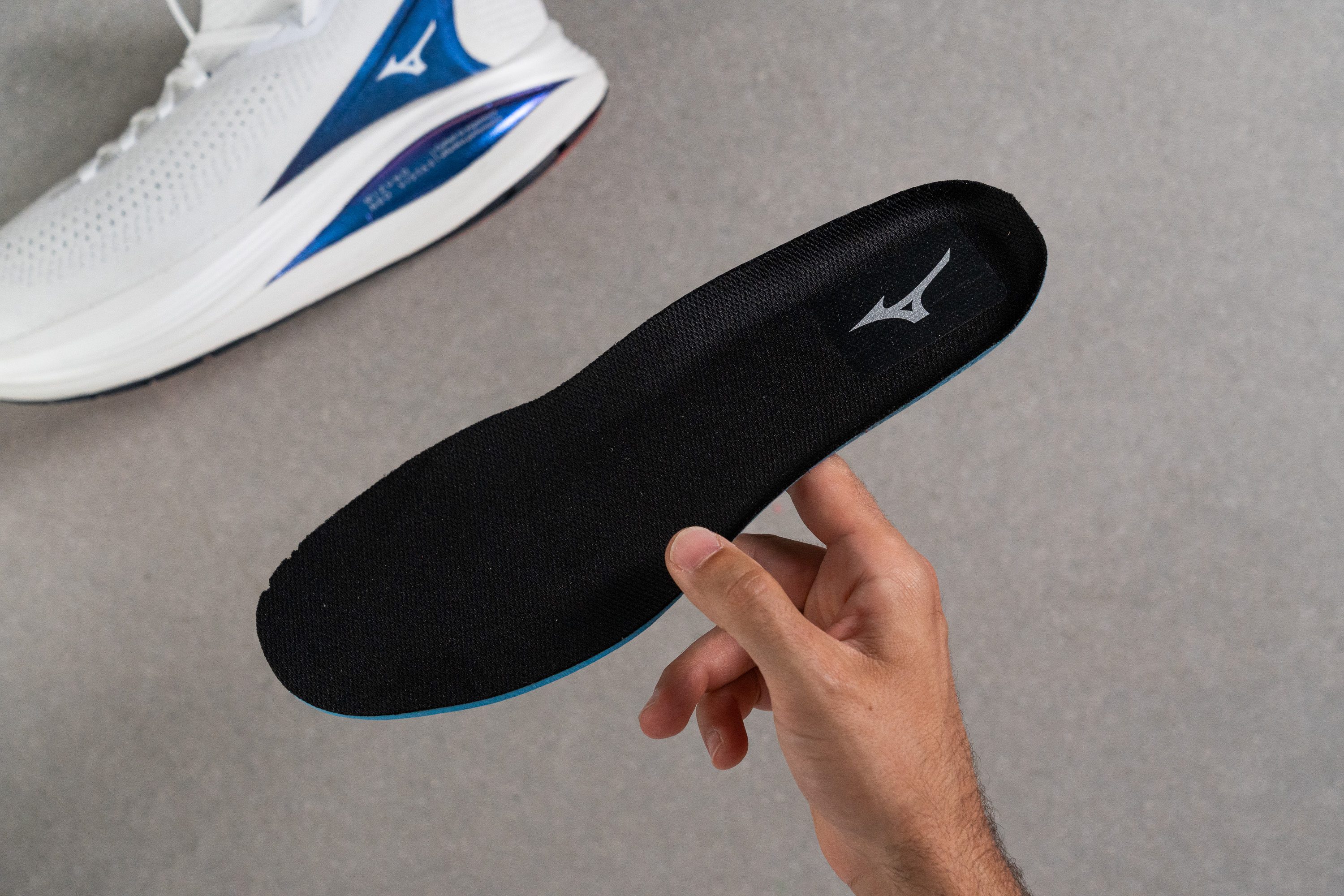
| Neo Vista 2 | Sí |
Rigidez de la mediasuela en frío (%)
Metimos las Neo Vista 2 en el congelador durante 20 minutos y solo se volvieron un 13 % más rígidas. Es un resultado estupendo, demostrando que siguen siendo blanditas y cómodas incluso cuando bajan las temperaturas en invierno.
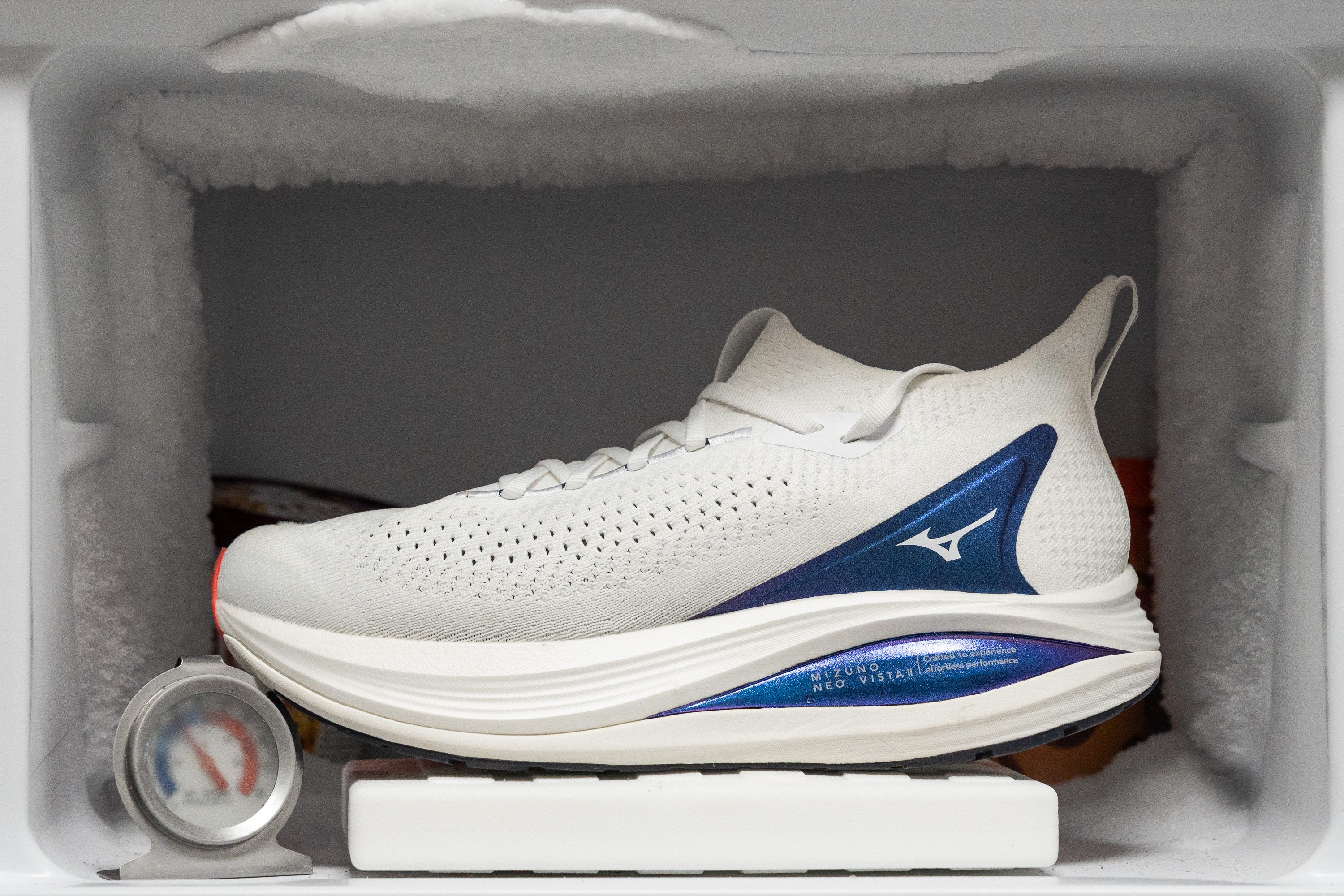
| Neo Vista 2 | 13% |
| Media | 24% |
Elementos reflectantes
Algunas marcas no les ponen detalles reflectantes ni a sus modelos premium, así que nos alegramos de ver que Mizuno no seguía esa mala costumbre. La seguridad es importante, y con esta larga franja reflectante, los coches definitivamente te verán desde atrás.
| Neo Vista 2 | Sí |
Acolchado de la lengüeta
Como en la mayoría de los uppers de knit, la lengüeta carece de acolchado y depende completamente del grosor del material. Pero como las zapatillas con una estructura tipo calcetín no necesitan que te ates los cordones muy fuerte, esto no debería ser un problema.
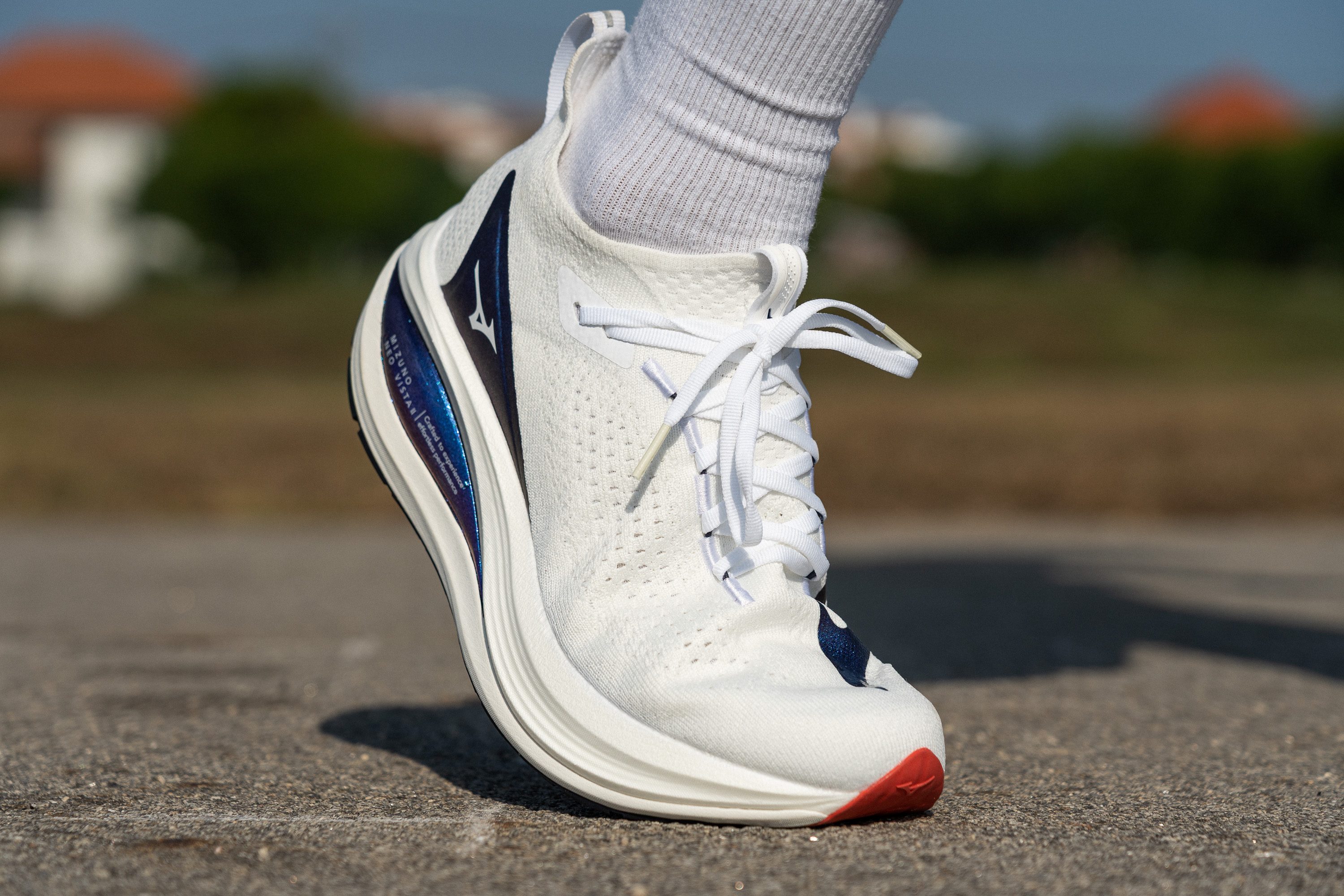
También vimos que este par tiene un sistema de cordones planos integrado directamente en el knit que utiliza ojales reforzados con costuras. En lugar de los agujeritos de toda la vida, los cordones pasan por huecos en el material para reducir los puntos de presión, excepto en los dos ojales superiores.
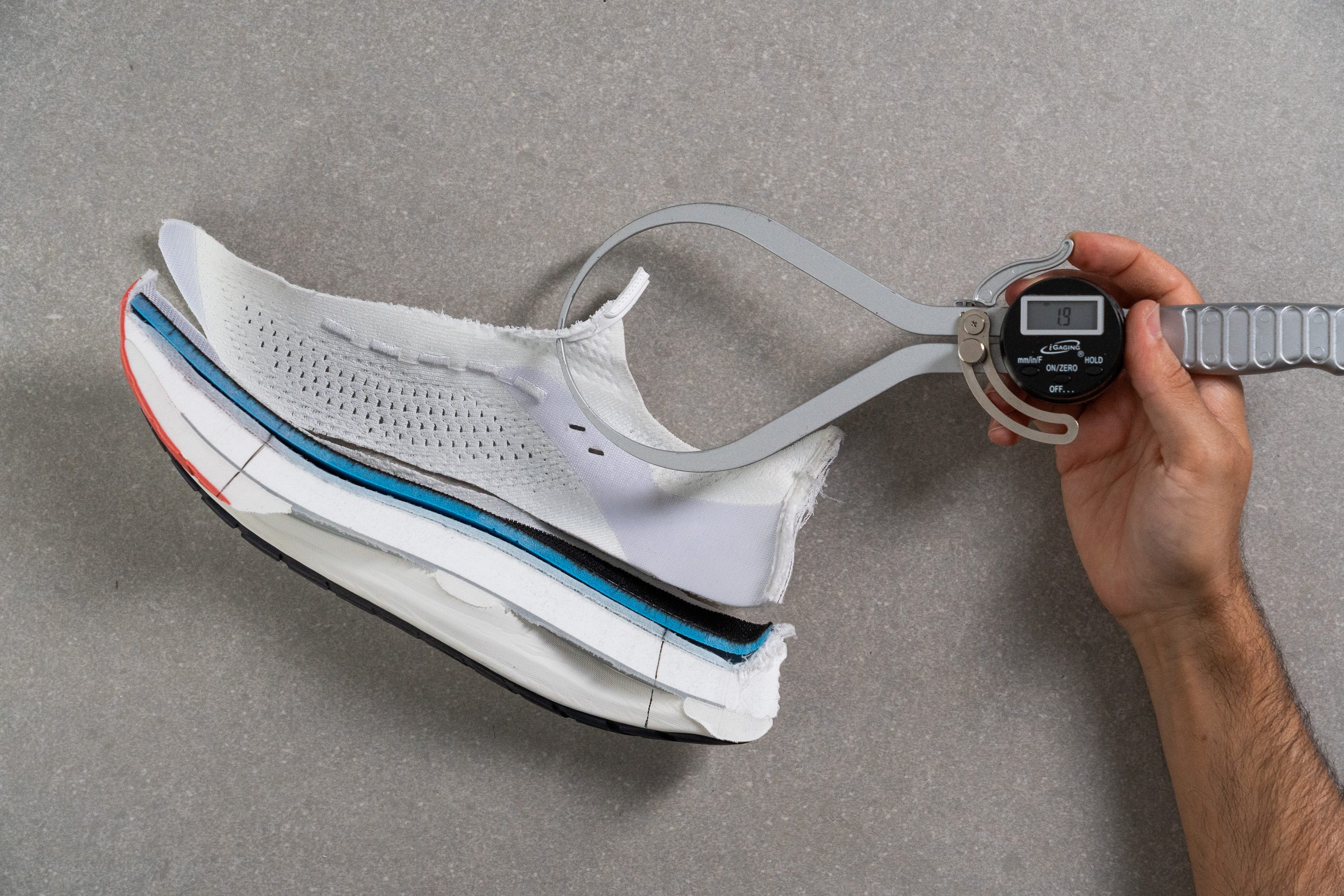
| Neo Vista 2 | 1.9 mm |
| Media | 5.8 mm |
Lengüeta: tipo de refuerzo
La lengüeta tipo calcetín ofrece un ajuste ideal y elimina completamente cualquier posibilidad de estar bailando de un lado a otro. Sin embargo, no a todo el mundo le gusta este tipo de upper, ya que las zapatillas de knit no terminan de encajar con ciertas formas del pie. Eso sí, para nosotros el ajuste estupendo, muy parecido al de las Nike Alphafly 3.
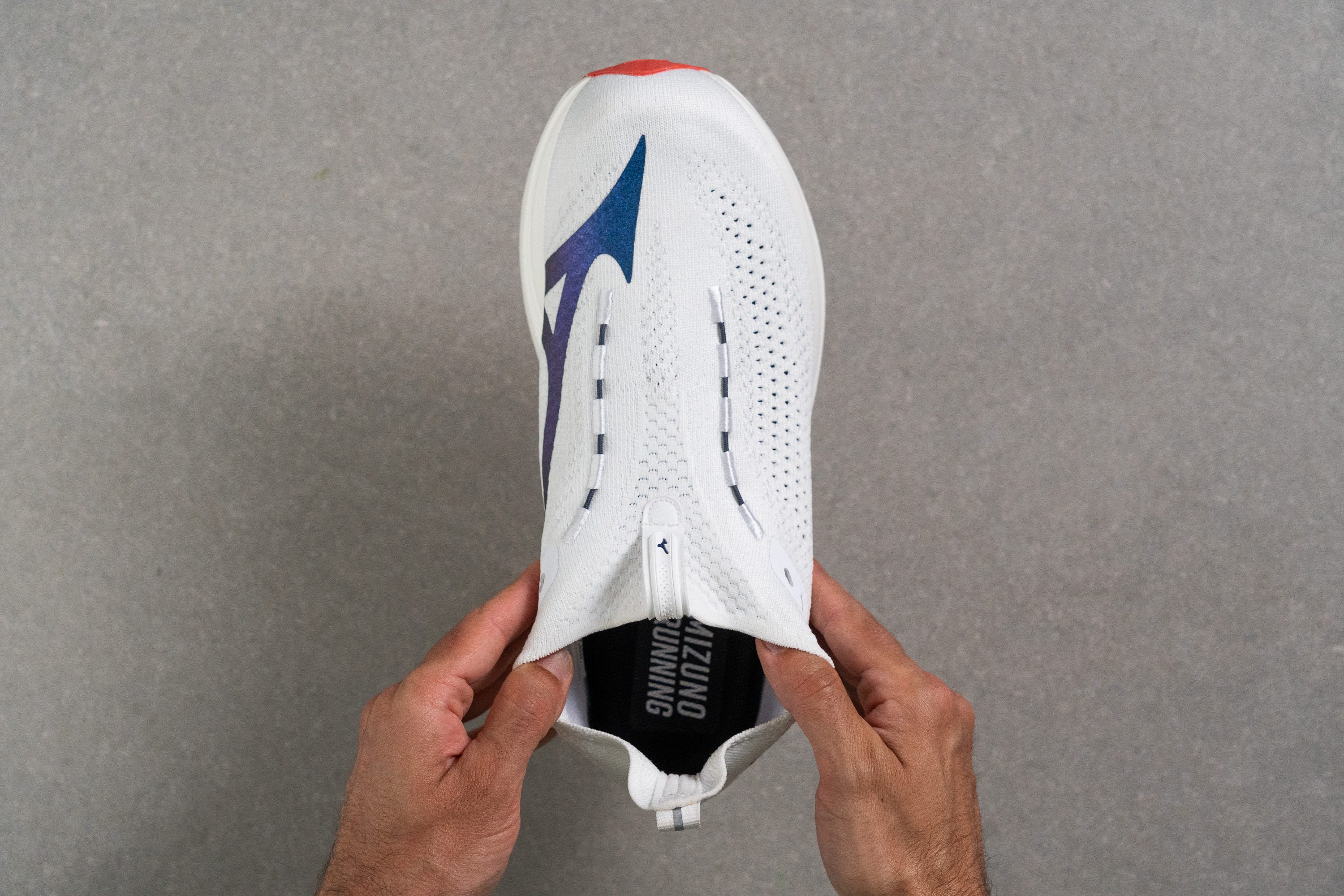
| Neo Vista 2 | Tipo calcetín |
Precio
Los aumentos de precio los odiamos tanto como tú, así que te vamos a dar la mala noticia directamente: las Neo Vista 2 cuestan un 10 % más que el modelo anterior.
A ver, hay más espuma que, además es (un poquito) mejor, aparte de otras pequeñas mejoras en general. Pero eso no es todo, su absorción de impactos también es impresionante, lo que probablemente termine de justificar este aumento de precio. Sea como fuere, que unas zapatillas cuesten un poquito más siempre da rabia, ¿verdad?
| Neo Vista 2 | $200 |
Tirador del talón
El talón tiene un tirador que juega un papel fundamental por el upper de knit, ya que es mucho más fácil calzarse gracias a él. ¡Y además la estética es chulísima!
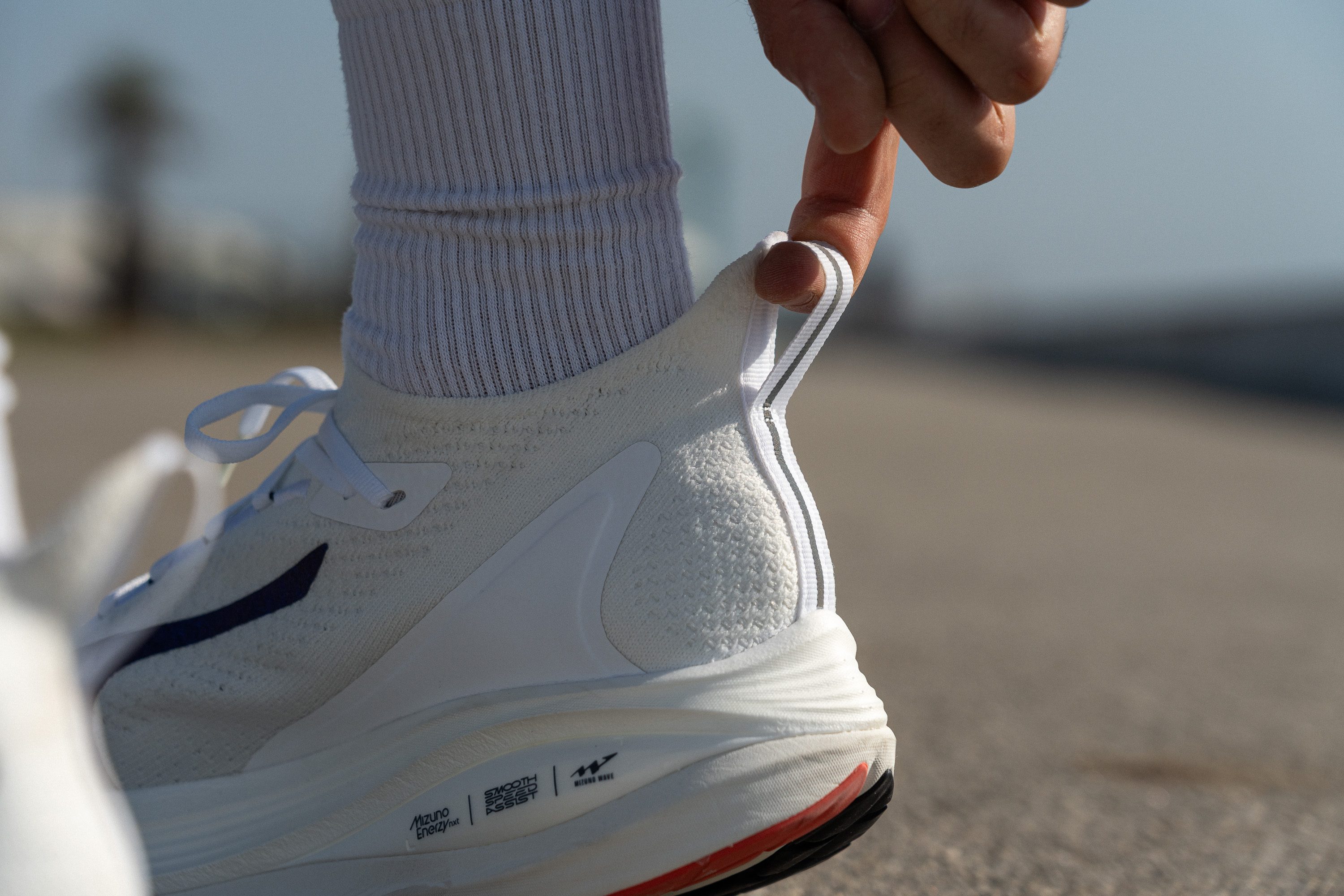
| Neo Vista 2 | Tirador circular |
Lengüeta
Hay otro tirador integrado en la lengüeta, que es algo que ya hemos visto en otros modelos, como las Nike Alphafly 2 o las ASICS Gel Nimbus 27.
